
In this week’s member guest blog post we caught up with Emmanuel Josserand, Sr Dir. Brand, Agency and Industry Relations, at FreeWheel. In this insightful piece Emmanuel looks at audience viewing habits in an ever-changing environment, reflecting on FreeWheel’s new report.
For more on the findings from FreeWheel’s Video Marketplace Report keep reading.
As consumers' viewing habits shifted with the escalating costs of streaming video, publishers had to adjust to creating a new age of premium video, with ad-supported video on demand (AVOD) platforms growing to complement subscription video on demand (SVOD).
This has resulted in a hybrid approach where the lines between SVOD and AVOD are blurring.
HVOD or Hybrid video on demand describes video on demand platforms that have a mix of offers – usually including a discounted subscription tier that contains ad-supported content as well as paid/free offers, with/ without subscription fees.
As subscription services move toward advertising options, premium video publishers must craft optimal viewer experiences across devices and content types.
Our latest Video Marketplace Report (VMR) for the first half of 2023, explores the digital video advertising landscape for the US and EUR*, looking into audience viewing habits, current distribution of ad views by platform and devices, as well as updates on programmatic adoption.
Key highlights:
- Hybrid video on demand (HVOD) services are becoming more prevalent as subscription premium video platforms embrace ad-supported tiers.
- Ad view growth has increased at a healthy rate in both the United States (6%) and Europe (15%), despite a period of industry-wide change and economic uncertainty.
- Optimising the viewer experience is increasing in necessity as audiences are inundated with choices for watching ad-supported premium video content.
Despite continued economic caution among marketers, ad view growth on premium video remained healthy in both the U.S. and Europe in the first half of 2023, with 6% and 15% growth respectively. There continues to be significant regional differences in viewing habits. Large screen viewing through Connected TV (CTV) and set-top-box (STB) platforms make up 80% of ad views in the U.S., while in Europe, audiences split their time between large (53%) versus small screens (47%).
In the U.S., there is an 80% increase in ad placements that utilise audience targeting, part of a trend towards refining the viewer experience through a push for relevancy in the ads served to individual viewers. Whereas in Europe, due to stringent data regulations (such as GDPR) and less data fluidity, targeting is primarily based on demographics.
U.S. ad views are evenly split across live and video-on-demand (VOD); in Europe — where free ad-supported streaming television (FAST) adoption is slower and linear remains strong — audiences are largely accessing video on demand (80%) to watch long-form content. The Live opportunity has not yet been realised, accounting for only 18% of ad views.
With available inventory increasing, particularly with the proliferation of HVOD services, optimising the consumer viewing experience is becoming a critical consideration for media companies now more than ever.
Additionally, while programmatic is growing steadily in the U.S. representing 35% of premium video transactions, in Europe programmatic stands at 19% of transactions, half of them being guaranteed.
The data set used for this VMR report is one of the largest available on the usage and monetisation of professional, rights-managed ad supported video content worldwide and is based on aggregated advertising data collected through the FreeWheel platform. This edition of the VMR, explores video advertising trends for the first half of 2023 (1H 2023) in the U.S. and Europe*.
*European countries included: Belgium, France, Germany, Italy, Netherlands, Nordics countries, Spain and the United Kingdom
Today, IAB Europe published a summary of the solution approach for supply chain standards which has been created to help online platforms meet supplementary advertising transparency requirements imposed on them by the EU’s Digital Services Act (DSA).
Under the DSA, online platforms must provide users with certain information about every ad carried on their sites or apps. The information must be available for each ad. IAB Europe’s DSA Ads Transparency Taskforce has developed a specification for an industry solution to enable the collection and delivery, and facilitate user-facing disclosures, of the required information. The document we are now sharing is a summary of product requirements and solutions, explaining how the standardised protocol will work and what different participants in the ecosystem will need to do to help responsible parties comply with these new DSA transparency requirements.
The protocol is a complete solution in that it provides the minimum elements necessary to facilitate communication between parties of the information necessary to make DSA-compliant disclosures. Implementers will then have the flexibility to render the DSA Transparency to end-users using their own preferred methods. Our protocol leverages existing mechanisms already in place in the supply chain, including the OpenRTB bid request/response. This is not a self-regulatory program
While not all content publishers meet the definition of online platform under the DSA, there are many, diverse, ad-supported content providers that do.
The DSA requires that, in conjunction with ads served on online platforms, the platform is responsible for disclosing certain information about an ad:
Given the nature of the digital advertising ecosystem, it is common, even typical, that online platforms do not themselves have all of the data needed to populate the information disclosures. Therefore, IAB Europe set out to standardise a protocol for compiling and delivering the required information through the ad supply chain such that it could be received by the online platform, or another party acting on its behalf, to make the disclosures to users.
In July 2022, IAB Europe convened a stakeholder taskforce for this purpose. The taskforce is made up of companies from diverse segments of the industry. Experts from these companies have met approximately weekly to develop and finalise an initial version of our industry solution for delivery of DSA ads transparency. Now with partnership with IAB Tech Lab, the IAB Europe Taskforce can fully focus on policy/legal questions so that IAB Tech Lab can focus on technical questions.
Our mandate for the taskforce was to produce a minimum viable product that would facilitate implementation of the ads transparency disclosures. Our anticipation was that, although standardisation was not absolutely necessary, Platforms could work organically with their partners to develop their own approaches to gathering the necessary information. Without a standardised protocol, it would be a chaotic and friction-filled process to navigate. With some standardisation, companies could be more effectively aligned.
One of our guiding principles was that our protocol should be adaptable to the many diverse circumstances in the ecosystem; there is no one-size-fits-all approach.
In the same spirit of flexibility and adaptability, our view is that platform publishers, since they are legally responsible under the DSA, should have control over (and visibility into) disclosures being made to their users, if they want it. But we also aimed to support optionality such that the disclosures could be made from within the ad creative. We explicitly sought to make it possible for platforms to put the information behind the widely-used AdChoices icon.
Other principles that guided our work were:
The attached Summary Document is not the full specification. The full specification will be published soon in collaboration with IAB TechLab. It will will become an official part of TechLab’s corpus of standards and specifications that define how the industry operates.
The Summary Document explains how the protocol works, and in many areas, the reasons why it is designed as it is. It provides enough information for companies to begin implementation. In our view, the bulk of the work of implementation falls into two areas:
These tasks can be started while awaiting the final technical specification. IAB Tech Lab will now steward the draft specification in order to undergo Tech Lab’s Working Group processes to update and finalise.
The Summary Document also suggests areas for future work, which IAB Europe looks forward to taking on in collaboration with TechLab.
If you have questions about the taskforce or the DSA specification, you may direct them to dsateam@iabeurope.eu. We look forward to continuing to support the industry in advancing transparency and choice for internet users.
Download the Summary Document here
IAB Europe Launches new Retailer Only Council to Advance its work on Retail Media in Europe
Since IAB Europe’s multi-stakeholder Retail Media Working Group launched in October 2022, members have been busy working on a number of initiatives to help educate and advance the retail media landscape including creating European level ‘agreed’ definitions, producing a 101 Guide and the development of market insights. The next phase for the group is to turn its attention to standards. A recent IAB Europe survey of over 100 Retail Media buyers and sellers found that over two thirds of buyers (70%) think the lack of standards for Retail Media is a barrier to investment.
To help advance the groups work on creating standards, it is key to have buy-in and support from retailers. IAB Europe has therefore created a new exclusive council for retailers.
This new Council will sit alongside the existing Working Group as a forum for trusted exchange between retailers in order to enable collaborative conversations, develop standards and enable retail media in Europe to thrive. Retailers who operate in at least one European market are eligible to become members of IAB Europe and join the Retailer Council as well as the multi-stakeholder Retail Media Working Group.
Meeting on a regular basis, the Council will review and input to IAB Europe’s key work tracks on retail media including the development of standards. Members of the Council will also have the opportunity to exchange best practices, share insights and innovations in a closed ‘retailers only’ forum.
According to the World Meteorological Organisation (WMO), the last 8 years have been the hottest on record. The signs are clear: global warming is well and truly here.
Since the 1980s, each decade has seen global temperatures higher than the last due to record levels of Greenhouse Gas (GHG) trapping heat in the atmosphere.
While that’s probably not news to you, the impact that digital technologies are having on climate change might be.
Despite the illusion that digital technologies are ‘clean’, their environmental impact is in fact massive.
Take digital advertising as a case in point: Since the early 2000s the space has experienced quasi-exponential growth. With spending on digital ads having risen from $10B to $378B in the last 20 years, according to eMarketer, it’s now the largest advertising medium in terms of investment globally.
The sheer growth of the digital advertising industry has had a clear and measurable impact on climate change.
Ready to Take Action?
So what’s the answer?
At IMPACT+ we believe digital advertising can be more sustainable.
And we’ve recently published a new whitepaper that provides everything you need to get started making your digital ads campaigns more sustainable.
The whitepaper sheds greater light on the true carbon footprint of the digital advertising industry and provides actionable solutions to reduce it.
Read through the five takeaways below, and download the in-depth white paper for more.
5 key Takeaways to Help Reduce the Carbon Impact of Digital Advertising
Download the Whitepaper
Don't miss out on these invaluable and actionable insights.
Click here to download our white paper and join the movement towards more sustainable digital advertising practices.
Plus join us on 28th September at 12:00 CET for IAB Europe's 'Digital Innovation: Start-Up Spotlight Webinar' where we will dive into the whitepaper and this topic in more detail. Find out more and register here.
More About IMPACT+
IMPACT+ award-winning sustaintech solution (trusted by leading global brands including L’Oréal, Heineken, AXA, BMW and Danone) enables digital advertising players to evaluate and reduce their environmental impact without sacrificing performance.
In essence, IMPACT+ builds new performance indicators and tools to help the digital advertising ecosystem use greenhouse gas (GHG) emissions and electricity consumption to inform their digital advertising strategy.

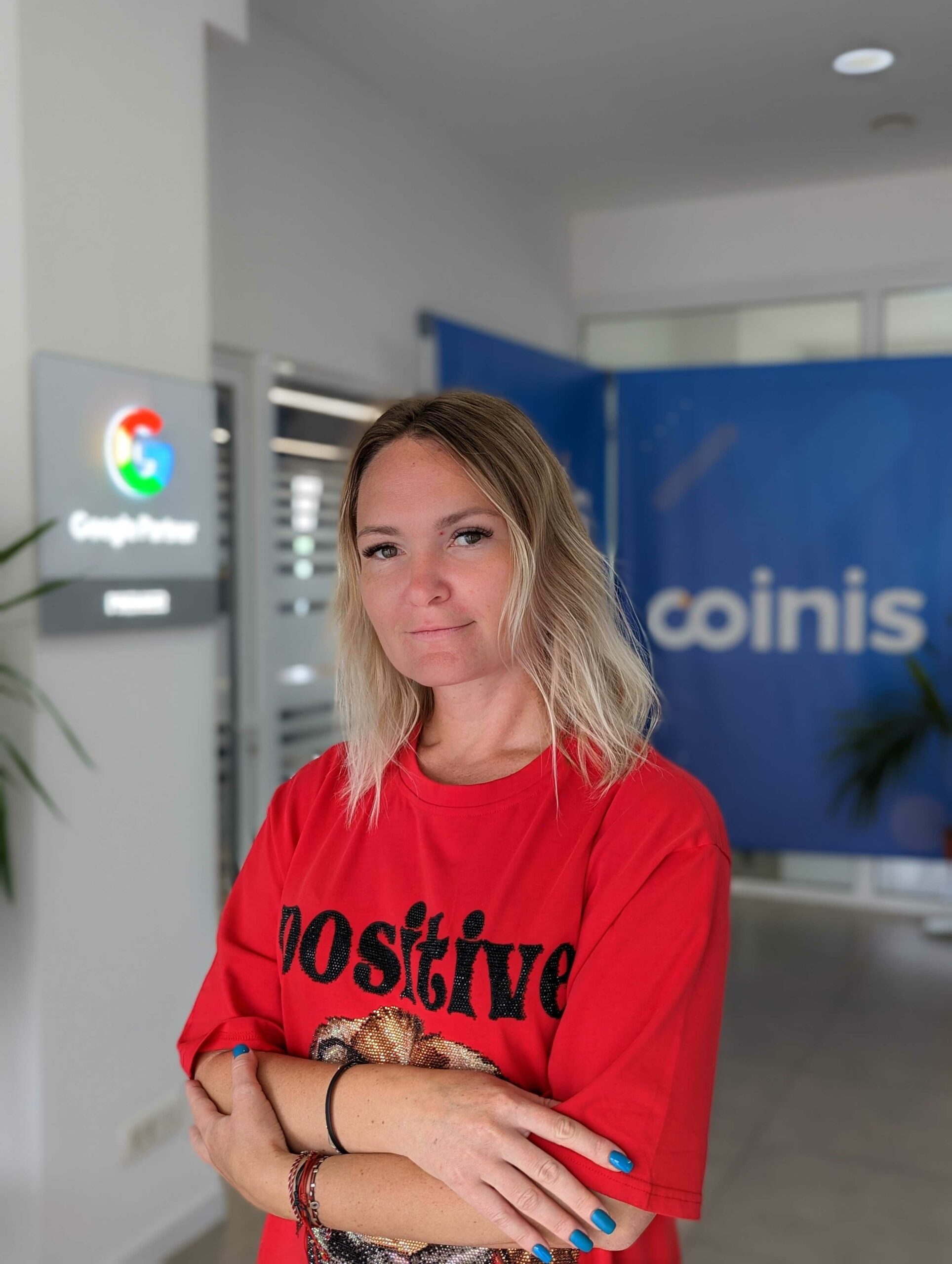 In this week's member guest blog post we hear from Tamara Jelic, Head of Business Development, and Anastasia Loseva, Head of Affiliate Programs at Coinis as they dive into the value of Affiliate Marketing
In this week's member guest blog post we hear from Tamara Jelic, Head of Business Development, and Anastasia Loseva, Head of Affiliate Programs at Coinis as they dive into the value of Affiliate Marketing
What is Affiliate Marketing?
If you are new to this topic, I am not going to bomb you with a dictionary definition but a more relatable situation. Ever stumbled upon a recommendation for a product on your favorite influencer or portal, clicked on it, and ended up thinking about buying a product that was advertised on it, or bought it immediately? You are in luck - you've been part of an affiliate marketing chain!
In simple terms, affiliate marketing is like a digital “word-of-mouth” where individuals or businesses recommend products or services. If someone makes a purchase based on that recommendation, the recommender gets a commission (earning by sharing). Imagine earning each time someone clicks on a movie recommendation you made or buys that super secure VPN you wrote about. Interesting, right? This is the magic of affiliate marketing: turning passions into paychecks without the heavy lifting.
Myths and Legends of Affiliate Marketing
There are certain points that you should be aware of before jumping on the train so I will present you with a few myths about affiliate marketing
Myth 1: The Overnight Profits
There is a misconception that many newcomers to affiliate marketing are sold on the dream of passive income, envisioning a scenario where they set up a website or a campaign and immediately start generating massive amounts of money. This misconception often arises from overly optimistic marketing pitches or testimonials that don't represent the average experience.
Imagine Sarah, who bought an online course claiming she’d start earning thousands within a week. She set up a basic website and waited. A week later, her earnings were negligible. Sarah realised that without a proper strategy, research, and consistent effort, this dream was far from reality.
Myth 2: The Illusion of Effortless Triumph
Affiliate marketing is more than a one-trick game. Successful marketers in this field are not sticking to one golden product or platform and sticking to it blindly. It requires a combination of market research, understanding audience behaviour, effective promotion strategies, and regular engagement.
The digital world is in a constant state of flux. What worked a month ago might not work today. You must be willing to learn, adapt, and innovate to stay ahead.
Myth 3: Oversaturated Markets Lead to Failure
Just because a niche is popular doesn't mean there's no room for newcomers. Often, market saturation is mistaken for high competition. But with the right strategies, even saturated markets can yield results.
Remember Sarah from the story above. How did she get better? Well, she diversified her affiliate marketing strategy by targeting both popular and emerging niches, ensuring multiple revenue streams and reducing dependency on a single market segment. And she bought traffic for her website of course.
On the other side, we have the legends
Legend 1: The Power of Niche Selection
Delving deep into a specific niche allows affiliate marketers to understand the unique needs, preferences, and pain points of their audience. This understanding leads to more targeted and effective campaigns.
Over time, as marketers consistently deliver valuable content and offers tailored to their niche, they establish themselves as authorities. This trust translates into higher conversion rates and lasting customer loyalty.
Legend 2: Relationships Fuel Success
Trust isn't just about ensuring genuine product recommendations. It extends to transparent communication with partners, ethical marketing practices, and prioritising the needs of the audience.
Think of brands that have built loyal partnerships. These partnerships flourish because both parties value and trust one another, leading to increased revenue and long-term collaborations.
Legend 3: Data-Driven Decision Making
In today's world, decisions based on gut feelings aren't enough. Analytics provide insights into user behaviour, campaign effectiveness, and areas of improvement, ensuring that decisions are backed by tangible data. So, setting up your tracking is highly important.
Companies like Amazon and Airbnb regularly leverage data analytics in their affiliate programs to optimise offers, understand market trends, and tailor their strategies, leading to increased profits and affiliate satisfaction.
How Modern Brands Are Boosting Revenue While They Sleep
Imagine this: It's midnight. While most of the city sleeps, a fashion enthusiast in New York stumbles upon a portal reviewing the latest sneaker release, clicks an embedded link, and makes a purchase. Halfway across the world, a tech aficionado in Tokyo is swayed by a YouTuber's recommendation and gets a new VPN. What's the magic behind these after-hours sales? Affiliate marketing.
Modern brands, from Nike to Apple, are leveraging this 24/7 marketing marvel to drive sales even when their offices are dark. By partnering with content creators and influencers, brands transform them into their very own digital salesforce, working around the clock. Every click, every sale made through these affiliates' platforms, means revenue for brands. It's a seamless synergy where brands expand their reach, influencers earn commissions, and consumers discover valuable products. And all this, while the brands potentially boost their bottom lines in their sleep.
Why Affiliate Marketing is Your Next Best Move
Low Investment, High Return: The initial cost of starting with affiliate marketing is minimal. All that is necessary is a traffic source (it could be a blog, social media account, traffic network) and a partnership with advertisers, owners of a product/service, if not direct, often through affiliate programs where there are rev-share or cost-per-action options.
Flexibility: One can work at their own pace, choose which products or services to promote, and even select the marketing strategies that suit them best. It really depends on the interest of the affiliate who will be running the product/service.
Diverse Opportunities: With countless niches available, there's no limitation to what can be promoted. From tech gadgets, software, and finance offers, to fashion accessories, every sector today offers affiliate marketing opportunities.
Passive Income Potential: Once there is a landing page and a url with tracking parameters out there, with the right marketing strategy and a good affiliate/s, it can keep earning revenue without active management of the advertiser (if the advertiser is not running the offers internally). For example, one landing page crafted the right way, can work on multiple networks and generate leads for months.
Your One-Stop Destination for Affiliate Mastery
But how do you navigate this vast realm? This is where companies like Coinis come into play. With 10+ years of experience in affiliate marketing, Coinis provides a platform tailored to cater to both advertisers and publishers/affiliates. Furthermore, Coinis has an experienced media buying team unparalleled in its expertise, possessing a great understanding of where to position which vertical, ensuring optimal visibility and conversion. Find out more here.
Join IAB Europe’s Digital Innovation: Start-Up Spotlight Webinar Featuring Conis
Affiliate marketing, with its passive income potential, is a realm waiting to be explored. As the lines between businesses and individuals blur in this arena, the opportunities only grow. Coinis stands at this intersection, ready to guide both advertisers and publishers/affiliates to their zenith of success.
We encourage you to join the webinar and inform yourself about the possibilities to scale your brand’s visibility and reach more customers/clients.
 In this week’s member guest blog post, we hear from Emmanuel Josserand, Senior Director, Brand, Agency and Industry Relations at FreeWheel on what we really mean by ‘Premium Video’.
In this week’s member guest blog post, we hear from Emmanuel Josserand, Senior Director, Brand, Agency and Industry Relations at FreeWheel on what we really mean by ‘Premium Video’.
The ongoing proliferation of video channels and content, combined with the convergence of digital and linear, is redefining the premium video ecosystem. With established channels advancing and new ones emerging, there is increased industry discussion around how to define the term ‘premium video’.
Strict definitions in the advertising industry can come with the risk of being too restrictive. But not clarifying terms such as premium also risks undermining standardisation and damaging advertiser trust in this inventory.
While there is still no industry-agreed definition of what constitutes ‘premium video’, there are a number of attributes that video inventory must typically meet to be considered premium, including:
Brand safety is an especially prevalent issue in digital advertising due to the widespread use of audience-first targeting models. These models prioritise reaching the audience over selecting the best inventory (and its context) to reach the right audience, a nuance that creates a level of uncertainty over the kinds of inventory advertisers purchase. Buyers therefore run the risk of their ads — and consequently their brand — appearing in environments that contain harmful content.
The kinds of content, and in turn, inventory, that is available via premium video marketplaces are thoroughly vetted, ensuring brands only access quality environments. Some advanced TV channels, for example, broadcaster video-on-demand (BVOD), must meet the same regulations as linear TV. This means BVOD platforms follow robust guidelines around inappropriate content and rising concerns such as misinformation.
Alongside regulations for TV-like environments, Stefan Havik, General Director and CDO DPG Network, believes that: “Fraud verification is an integral safety measure for protecting investment and campaign performance. Clarity is key to prevent wasted spend on fraudulent or poor-quality inventory that doesn’t deliver value.”
Across all channels, advertisers and agencies are demanding visibility over where they invest their media spend. When buyers purchase premium video inventory, they have transparency around the sellers they purchase from, which is a necessity for maintaining trust in premium video inventory.
Transparency is also important for sellers in terms of which buyers they trade with and which ads they run, as they must ensure ad creatives meet regulations to preserve the quality viewing experience. For this reason, premium video is usually traded through direct sales and private marketplaces (PMPs), which gives media owners greater control compared to alternative transaction methods such as open auctions and exchanges.
Audiences have a particular emotional investment in the premium video content they watch because they select precisely what, when, and where they tune into it. Studies from IAS have also found the quality of advertising environments has a significant impact on audience engagement and brand perception, with high-quality environments being more engaging and low-quality ones presenting a risk to brand objectives.
“Through the emotional connection between viewers and content, premium video delivers a superior advertising experience. This is further amplified by high-impact ad creatives and the big-screen devices audiences use,” commented David Rasmusson, Product Manager at ViaPlay.
Buyers need to be assured that the inventory they invest in works, making accurate verification and reporting essential. Advertisers and agencies require correct and complete metrics, such as viewability, for their video campaigns to understand the impact of their spend and justify maintaining or increasing budgets.
Furthermore, attribution remains critical for learning how media delivers against brand goals. Premium video measurement can tie audience actions to specific ads, meaning buyers can trust their spend is driving real value for brands.
Audiences are moving between many different channels to watch their favourite shows. To achieve sustainable growth, brands need to drive incremental reach. Six in 10 UK CTV viewers who took part in the AudienceXpress consumer study now watch more ad-supported streaming platforms than linear TV and 46% use free streaming platforms daily.
Audiences continue to have a huge appetite for long-form, professionally produced entertainment. However, premium video is now not just focused on that type of inventory. Due to changing user viewing habits, it also now encompasses a broader range of content — including short-form clips and immersive, high-quality shows. The quality of the production is what remains unchallenged as the most likely content to capture audiences and is therefore the most valuable environment for brands. The rapid and widespread audience adoption of premium video channels makes them effective at helping advertisers connect with audiences that could otherwise be difficult to reach.
Proving premium’s worth: Does it truly deliver stronger performance?
Identifying value brings the conversation back to measurement, which is perhaps the biggest challenge of a diversified ecosystem. New video measurement frameworks place a lot of emphasis on reach, which remains highly important, but doesn’t capture all premium video’s value.
Premium video measurement goes beyond baseline viewability standards and instead incorporates attention metrics and completion rates, which according to the forthcoming FreeWheel’s The Delicate Art of Balancing Ad Load report, stands at an impressive 94% for long-form premium video content. With the right tools to combine delivery metrics with attention, this is where premium video really shines, meaning buyers can be assured of premium video’s effectiveness.
As Ralf Hape, Managing Director, Sky Media Germany puts it: “‘Premium’ means quality, and measuring quality is not an easy task as there is no standardised measurement criteria in place yet for BVOD and CTV. There are some indicators that come close to a standard, such as VTR, Completion, and Viewability Rates, but they are not a “single currency” for non-clickable inventory. When measured against all these parameters, however, premium video is uniquely positioned and at the forefront of quality.”
A major reason for this is that broadcasters and premium video providers are carefully crafting their ad loads to create the best viewer experience, an endeavour that requires them to consider factors such as ad duration, ad break duration, and the number of ads included in a break. Refining this practice across screens, for different lengths of content, all whilst maximising revenue and enabling brands to achieve their upper and lower-funnel goals is no small feat, but it is one that’s vital.
Ultimately, premium video is inventory that puts the viewer experience first, which is equally beneficial to brands and premium video providers. Premium video drives quantifiable results for advertisers, whether they are looking to drive awareness or sales, and buyers need to carefully explore which video channels best enable them to achieve this.
As they do so, it’ll be crucial to remember that brand safety, transparency, engagement, trust, and quality reach are the core attributes that define what premium really means.
On September 20 & 21, 2023, DMEXCO will be opening its doors to leading businesses and pioneers from the world of digital marketing. The motto for this year’s event in the Rhine metropolis of Cologne will be “Empowering Digital Creativity”. Across multiple keynote sessions and panel discussions, guest speakers will explore a variety of topics, including how artificial intelligence is transforming our day-to-day life and our work in the digital sector.
Industry Giants Present their Businesses and Products
Every year, DMEXCO attracts tens of thousands of digital professionals – it’s not hard to see why the trade show for the digital industry is so popular: 2022 saw 560 partner companies come together at the Koelnmesse exhibition center to present their ideas, products, and solutions to an attentive audience of experts.
Big names will once again feature on the list of DMEXCO exhibitors for this September, including:
Highly Sought-After Experts Share their Insights
DMEXCO’s 40,000 visitors will be treated to a program containing over 200 hours of professional insights and innovative ideas delivered by more than 600 speakers. The event has once again succeeded in securing a lineup of industry giants, who will be providing an exclusive look at the challenges they face and the solutions they propose for the industry’s future. The following speakers are among this year’s highlights:
IAB Europe Will be Hosting Two Sessions at This Year’s DMEXCO
Amongst the industry experts, IAB Europe’s Chief Economist, Daniel Knapp will join the Main stage for the Retail Media Summit on 20th September at 14:15-14:28 CET for a session on ‘Retail Media in Europe: What’s The Market Worth? What Standards Are Coming Up?’ Register for the session here.
You can also join a panel of experts from IAB Europe’s Programmatic Trading Committee on 21st September at 09:45-10:15 CET for ‘Programmatic Advertising in Europe: Latest Trends, Attitudes and Growth Drivers’ at MC6B: Register for the session here.
What Else is on the Agenda? The Hottest Issues of our Time
At the heart of DMEXCO lies panel discussions where experts explore key topics that are currently shaping the industry. For example, visitors can look forward to “AI in marketing – a revolution?” on the first day of the event. During the panel discussion, thought leaders will discuss what changes artificial intelligence is bringing and will bring to the day-to-day work of marketers, with a focus on aspects relating to implementation.
“A change is coming: current trends in the media industry” will also be addressed by leading minds, who will offer an in-depth look at the developments currently keeping professionals across the media landscape on their toes. If you want to build the perfect media mix, take the right approach to innovations, and reach your target groups in a lasting way, then don’t miss it!
The advertising trend of the hour will also be given a fitting platform on the first day when the discussion “Status quo in retail media” will unfold on the Media Stage – where the industry’s innovators will talk about how further stages in development could boost efficiency even more. The rapid evolution experienced since the Retail Media Summit at DMEXCO 2022 will of course also be discussed.
On the second day, the panel “Sustainable advertising – solutions for sustainable, carbon-reduced digital communication as part of holistic ESG strategies” will be one of the main attractions. During this session, Teads and OMG Momentum will present specific study results to show how a digital campaign’s carbon footprint can be significantly reduced in practice. The panelists will also explore best cases and real-life examples of campaigns they’ve analysed, which highlight how well-known brands have managed to combine advertising success with environmental protection.
“Digital Fashion – The Phygital Network”, an event dedicated to digitalisation in the fashion industry, is a real newcomer this year. Co-organised by Deutsches Mode-Institut (DMI), the format will revolve around the topics of e-commerce, personalisation, customer experience, digital marketing, as well as sustainability and transparency and their impact on the fashion scene.
w3.vision will join DMEXCO again this year and will centre around the latest developments in the dynamic market of the new Web.
You can find more information on the conference agenda here and details on exact slots and spots online. Bookmark the sessions that appeal to you and create your very own DMEXCO experience ahead of the event!
Business Interaction at the DMEXCO Worlds
The DMEXCO Worlds create the perfect framework for subject-specific interaction and networking. Each world represents a specific sector in the digital economy.
The World of Agencies focuses on digital agencies, with the Agency Stage offering a range of sessions full of practical know-how. Agencies will also have the opportunity to meet top decision-makers and forge new collaborations.
The World of E-Commerce offers a space for companies and speakers from the dynamic field of online retail. Retailers, technology suppliers, and service providers will assemble here to shape the future of e-commerce.
The World of Media brings together leading marketers, media companies, data and targeting experts, and service providers from the media sector. The modern, digital media landscape is thus the focus here.
At the World of Tech companies and visitors alike will find a dedicated space for tech innovations. Whether VR/AR, 5G & connectivity, blockchain & Web3, the metaverse, cryptocurrencies & NFTs, cybersecurity, or cloud computing – there’s something for every tech enthusiast.
Don’t Miss Out on Your Ticket to the Digital Future
Visitors can buy their tickets for DMEXCO 2023. The following price categories are available:
Secure your ticket for DMEXCO now and be part of Europe’s leading digital marketing and tech event in Cologne on September 20 & 21!
As summer vacations draw to a close and we gear up for an exciting new season in the world of digital advertising, why not prepare yourself by diving back into some of the basics and kick-start the new ‘term’ ahead of the game?
From our 101 Explainer Video Series to our educational and practical Guides, we’ve outlined some of our most valuable resources below for you to explore, re-educate, and excel as we move toward the end of 2023.
IAB Europe Explains
The ‘IAB Europe Explains’ video series brings together industry experts from across our membership to provide overviews and explanations that will help you make sense of the latest topics and trends in our ever-evolving and changing ecosystem.
From the latest Economic Outlook to Retail Media, Sustainability, Disinformation, and more, find out everything you need to know in our video series below:
The videos are between 5 to 15 minutes long, so sit back, grab a coffee, and become an industry expert in no time.
IAB Europe Guides & One-Sheets
Whether you want to brush up on the basics of programmatic CTV, understand how to make more sustainable business decisions, or get an introduction to the world of Attention, our guides and one-sheets are here to support you:
IAB Europe Research & Insights
We also have a wealth of knowledge, stats, and facts at your fingertips with some of our most recent research projects:
For all this and more head over to our Knowledge Hub and check out our resources today!
IAB Europe is pleased to welcome three new retailer members to its Retail Media Working Group; ICA, Schwarz Media and Ocado Retail. These businesses join Amazon, Bol.com and Douglas in the Working Group as well as other leading retail media businesses.
Since the Working Group launched in October 2022, members have been busy working on a number of initiatives to help educate and advance the retail media landscape. The addition of new retail businesses from across Europe has helped to further ensure IAB Europe represents the views and needs of all stakeholders across the retail media ecosystem. This is particularly important as IAB Europe embarks on standards and best practice guides for the industry. .
Ben O'Mahoney, AdTech & Data Partnerships Lead, Ocado Retail commented on joining IAB Europe: “Ocado Retail is a member of IAB Europe’s Retail Media Working Group. As a member we have the opportunity to drive growth and shape the future landscape of this sector via the creation of definitions and standards, as well as providing key market education. IAB Europe is crucial to developing Retail Media as a credible media channel for advertising buyers and we are excited to be a part of this journey.”
Coming up in September
In September, IAB Europe will publish a 101 Guide to Retail Media which will provide a modular definition of retail media, help buyers to navigate the retail media landscape, understand how to buy retail media ads and get insight into measurement.
The results of IAB Europe’s Retail Media Standards survey will also be published. Industry stakeholders were asked to choose and priortise what standards are needed. The findings will help the working group as they embark on their next mission to bring European level standards to retail media.
Sign up for our webinar on the 13th of September to learn more about these initiatives, hear from industry experts and get an up to date view on the retail media market in Europe.
Capability Map of Retailers across Europe
IAB Europe is currently collecting information about the on-site, off-site and in-store opportunities offered by each retailer in Europe as well as the targeting and measurement options available.
The data collected in the survey will be used to produce a Pan-European Retailer Capability Map. It is intended that this will be updated at regular intervals. If you would like to be included in this initiative, please contact Marie-Clare (details below).
If you are a retailer or working in the retail media industry and want to learn more about getting involved with IAB Europe’s work in this area, then please contact Marie-Clare Puffett (puffett@iabeurope.eu)
Join us for a special two part webinar series dedicated to Google Privacy Sandbox Testing. The webinars will provide an update on the progress of Privacy Sandbox and show how companies can start testing and then share results.
The series will kick off with an update on the different integration/testing demos for Privacy Sandbox covered by Chrome followed by a second session with the UK’s Competition & Markets Authority (CMA) on testing guidance including framework and result sharing. Both webinars will be hosted live and will include audience Q&As to allow participants to ask any questions they may have to better prepare for the future.
Registration is free to IAB Europe members, National IAB members and the wider digital industry.
Privacy Sandbox Survey
If you’re involved in the testing of the Privacy Sandbox APIs, or plan to get involved, please spare 5 minutes of your time to complete our survey here.
Participants' responses will be aggregated to identify common questions and concerns, and ensure our panelists offer you meaningful support and insights during both upcoming sessions. Individual responses will be kept confidential by IAB Europe. The deadline to participate in this survey is the 29th August.
See below for more!
Webinar 1 - Privacy Sandbox: Get Ready for Testing Webinar - Tuesday 29th August | 16:00 CET
In collaboration with Google we are hosting a webinar on Privacy Sandbox which focuses on how companies can get involved in testing and which tools are available for testing and which allow you to check how prepared you are for the deprecation of 3P cookies.
Chrome started the rollout of the Privacy Sandbox APIs to all Chrome users in July and plans to deprecate 1% of 3P cookies in Chrome browsers by Q1 2024 and 100% in the second half of 2024. With the deadline nearing quickly, this webinar provides a unique opportunity to all companies in the digital industry to learn more about how they get involved in testing and how to best prepare for the future.
Speakers:
Webinar 2 - Privacy Sandbox: Testing Guidance & Results Sharing - Tuesday 12th September | 15:00 CET
In collaboration with the UK’s Competition & Markets Authority (CMA) we are hosting a webinar on Privacy Sandbox testing methods and proposed metrics, and how results of testing will be used in the CMA’s assessment of the Privacy Sandbox changes The CMA will present an overview of their testing framework alongside the relevant metrics and how companies can share their results with the CMA. This is a must attend session to hear from an independent body on their assessment of industry feedback and the next steps needed.
Speakers:
Programmatic advertising has transformed the way digital ads are bought and sold. First introduced to the market in the mid-2000s through the advent of real-time bidding (RTB) technology, advertisers can now target specific audiences with greater precision and efficiency through automation. Something that adds immense value to any media plan. But what is the real value of programmatic today and how has it evolved from Header Bidding and Supply Path Optimisation (SPO) to tackling new and emerging channels and formats such as AV and TV?
This year, members of IAB Europe’s Programmatic Trading Committee have been sharing their thoughts on the value of programmatic advertising in Europe today in our dedicated blog series. In this edition, we speak to members on why continued programmatic investment is important, discuss the essential elements of programmatic trading, and speak on how programmatic has evolved.
A big thank you to the following contributors for sharing their thoughts
We begin with an overarching comment from Nick Welch, who is the Chair of IAB Europe’s Programmatic Trading Committee:
“Advancements in programmatic have helped advertisers improve their efficiency in buying and the measurement of campaigns, across multiple digital screens hugely over the years.
Programmatic buying and selling of inventory democratised the industry and has allowed many more brands to be able to reach their audiences through advertising. However, the increasing fragmentation and sheer volume of supply - coupled with the proliferation of bad actors trying to cash in on the programmatic supply chain - has led to confusion and some scepticism among advertisers of the true value of buying across the open web.
As an industry, we need to simplify our processes as well as ensure transparency across the whole supply chain in order to maximise ROI and optimisation for advertisers, and revenue for quality publishers. It’s really only when you understand and measure a campaign in its entirety, from pre-bid to post-bid, that you can truly optimise performance, maximise ROI and minimise wastage.``
The Value of Programmatic Q&A with some of the members of IAB Europe’s Programmatic Trading Committee
Q1. What is the main value of programmatic to you, and why do you think we should increase investments in programmatic?
Nick - “When executed well, programmatic has the potential to offer advertisers the efficiency, scale, and performance that they are looking for from their advertising budgets, to maximise their return on investment (ROI) and improve each subsequent campaign.
Issues arise, however, when advertisers mistake reducing their spending on measurement, or other verification and optimisation tools, in their program pre-bid, as making ‘efficiencies’. The net result of this is that spend is actually less effective and likely to lead to more waste, reducing their ability to optimise towards ‘working media’.
The best way to maximise value in programmatic is to ensure your ads are viewed by humans, in safe and suitable environments across screens. That increase in investment upfront leads to improved effectiveness, removes waste, and delivers a much better return on ad spend (ROAS), as well as better peace of mind for marketers.”
Azad - “The value of programmatic lies in being able to deliver safe, campaign precision at scale, allowing for more time for creative strategy and thoughtful planning of campaigns.
When executed well, the technology offers seamless and secure campaign delivery, which is achieved through trusted supply paths, knowledge sharing, and maintaining good relationships across the ecosystem.”
David - “The main advantage of programmatic, from my point of view, is its versatility. Primarily it can be used to purchase advertising across a range of different ad types. It can also be used across media channels such as video, Connected-TV (CTV), audio, and Digital-Out-Of-Home (DOOH).
Programmatic brings all of this together and enriches it with advantages, such as precise targeting and an auction model, where the buyer controls the price they are willing to pay, and the seller has the advantage of always selling to the highest bidder.”
Lisa - “Programmatic technology was introduced to solve challenges of scale and efficiency across the open internet. DSPs arose to facilitate and optimise all aspects of buying, and SSPs were introduced to facilitate and optimise all aspects of selling. We are still operating within this overly simplistic, category-based view of the digital advertising supply chain, and it’s time to put the days of ‘one-size-fits-all’ behind us.
Programmatic is now being applied to a growing number of use cases. Buyers and sellers of digital media should no longer be limited to the previously identified set of constraints. Rather than thinking about the alphabet soup of company types, such as DSPs, DMPs, CDPs and SSPs, we should instead start thinking in terms of supply chain components, including: media planning, dynamic bidding, audience ingestion, audience targeting, audience matching, inventory curation etc.”
Q2. Since Real-Time Bidding came into play and programmatic was born, what are the key elements of programmatic advertising that have always been and will remain essential to programmatic? What elements of header bidding and SPO are still vital to the programmatic supply chain?
Nick - “Transparency across the supply chain is fundamental to building trust in advertising across the open internet. In the fragmented landscape, Supply Path Optimisation (SPO) has enabled marketers to make smarter decisions by understanding how a supply chain is performing with impression-level granularity in real-time.
Buyers can compare quality CPMs (qCPM) across different strategies and have an apple-to-apple comparison, providing full transparency on the cost of media at the impression level and how it correlates to verification signals such as viewability, IVT brand safety and brand suitability.
Effective SPO tools help buyers identify waste across advertisers' media plans and can enable them to understand the relationship certain signals have with success metrics, such as conversions, so they can realise the true value of their programmatic investment and optimise the quality of the inventory purchased to drive results. Adoption of SPO technologies has been slower than you might expect given the value they can bring to marketers’ budgets. We are, however, seeing this change as more brands and agencies begin to understand that the ROI achieved makes it a worthwhile investment. Especially as more scrutiny is placed on ‘how’ budgets are allocated.”
Azad - “programmatic has and always enables good competition in the market; better yields for publishers, and increased choice and reach for advertisers.
By automating the transaction we already see the benefit of the hours saved negotiating each placement. The challenge with this though, which has led to the rise of solutions such as header-bidding with the resulting flurry of duplication, has been the need to see parity and fair market share for innovative technologies.”
David - “I see personalisation and automation of the entire buying process as key elements of programmatic. Small and large advertisers have access to almost all ad spaces, formats and media types thanks to Demand Side Platform (DSP) access.
Header bidding fundamentally helps publishers increase revenue simply by putting all advertisers in the same starting position and allowing a fair auction between them. I believe that with the help of header bidding, working with SPOs will gradually become easier, because advertisers will learn to choose the shortest path available to the publisher. But I would be very happy to see the same development SPOs have seen, with Demand Path Optimisation (DPOs), which is still lagging behind. “
Lisa - “It is important to note that publishers and advertisers have a vast amount of use cases when it comes to programmatic, and it has come a long way and should be expected to adapt to the needs of the customers it serves, not the other way around. I see the ability of data-targeting as one of the key elements of programmatic that is here to stay as programmatic advertising leverages vast amounts of data to identify the most relevant audience segments. It utilises various data sources like demographics, browsing behaviour, contextual cues, location, and more, to deliver personalised and highly targeted ads to the right audiences, increasing the chances of conversions.
It is also important to note that as the ecosystem has shifted away from cookies and other identifiers, the buy side has been feeling the impact in terms of audience matching capabilities. As a result, some buyers shifted audience onboarding and targeting to the sell side, where they’re finding better results. ”
Q3. How do you think programmatic has evolved in the last 1-2 years? What key advances have been made? How has programmatic enabled efficiencies in media channels such as CTV, audio etc.
Nick - “The ability to buy ad space omnichannel - across any screen in multiple formats, through one point of entry - is a huge evolution of course. However, programmatic at its most fundamental, including the improvements of measurement at the impression level and the power we now have at our fingertips to ensure campaigns are targeted and measured effectively across all of those screens, before we even commit to the spend, should not be underestimated as one of the key innovations in our industry.
And most importantly, to use the information we can gather both pre-bid and post-bid to then optimise the campaign is immensely valuable. It’s fundamental to building the trust that advertisers need when investing their budgets - especially when those budgets are also being challenged by macroeconomic environments.”
Azad - It’s encouraging to see the steps that many independent and holding companies have taken to enable skilled and smart people in their organisations to innovate technologies, processes and leverage in the programmatic space. Hire more of them!”
David - “Over the last two years I’ve seen many key developments, mainly in extending programmatic buying to other devices that are increasingly connected digitally, such as TV and radio. But we are also seeing digital OOH or other devices come into play here. It's very useful for advertisers to be able to buy all media types from one place and through one technology. As an industry we've started to pay more attention to the supply chain, both in terms of the carbon footprint it leaves and also in terms of its buying efficiency and quality (a shorter journey is more simple and cost effective).
Additionally with the end of cookies forcing the entire industry to develop new and alternative solutions, we have been able to create options that are more interesting for a broader concept of programmatic buying that involves multiple media types and devices. User identity solutions coming to the marker are one such example of this.``
Lisa - “We have seen that both buy-side and sell-side think about their supply chains and how they can best leverage various technical components to achieve their objectives. For example, we have seen CTV publishers leaning in on programmatic technology to automate a successful direct IO business. On the buy-side, we see that biddable programmatic is strong, but there is an increased emphasis on performance-based campaigns, as well as e-commerce and retail business. In the TV arena specifically, premium online video inventory will become one with broader TV, just activated in a different way. Here programmatic can bring interoperability to current format and platform silos that should result in more spend directed towards diverse environments, which will positively impact the survival of the open web.”
Q4. What are the biggest innovations and advancements in programmatic advertising today? Which channels and formats should we be focusing on in the programmatic space?
Azad Hosenbokus - “There are two sides here. One is the need to challenge for improvements in how we currently trade and mitigate for the crutches that we rely on. The second is the need to provide solutions that preserve an open internet and respect audience experiences. Ultimately, we should emphasise education, excellence and best practice ahead of innovating ourselves out of a created confusion, aka Header Bidding and SPO.”
David Bauckmann - “If I had to name one thing that's most exciting right now, I would definitely name CTV, or the intersection of TV and programmatic buying.”
Lisa - “Let’s not neglect the immense impact that the growth of commerce and retail media platforms are having on the programmatic industry. These days, retailers might find themselves in the role of an advertiser, a data owner and a media owner, and programmatic ad tech should be nimble and equipped to support multiple functions right alongside the retailer as needed. In other words, success in commerce and retail media require a consolidated tech offering featuring a complex set of capabilities that have historically existed across multiple company types. Programmatic will play a vital role in the development of this space”.
Q5. What does the future hold for programmatic advertising? What do you see happening in the next 6-12 months?
Nick Welch - “With cookies destined to disappear by the end of 2024, any companies that have not yet begun testing and experimenting with different and new targeting and measurement tools will certainly be ramping up their efforts. We’ll see continued developments in the tools that don’t rely on cookies and companies leaning into learning how other signals correlate with improved performance based on their KPIs.
We’re seeing AI, especially Generative AI, mentioned everywhere right now, and certainly we’ll see more experimentation throughout the industry in how it can support and improve both consumer interactions with brands as well as the back end production of ad campaigns, from creative through to targeting, optimisation and measurement.
Recent developments in AI have shown that it’s going to revolutionise the customer experience for many brands. It’s worth noting that AI and machine learning (ML) has been utilised in tools like fraud prevention and detection for years and will continue to develop and innovate with new solutions across programmatic advertising.
CTV is only going to keep growing as more supply becomes available through programmatic channels. The industry will start to align on measurement for this hugely growing sector, which should help to reduce fragmentation and ensure more holistic measurement across channels.
More brands and agencies will recognise the impact that building in pre-bid solutions for their planning, targeting and measurement has on their ability to truly understand the value of their ad campaigns, ensuring their ads are seen by humans, in premium contextual environments, reducing any wasted spend and ultimately improving ROAS and protecting marketing budgets.”
Azad - “I believe programmatic will evolve into a system of higher quality creative execution and will demonstrate more respect toward audiences.Ad supported gaming, for example, where there is a logical need to create native experiences in a way that can be addressed at scale to attract higher quality advertising budgets will see growing traction.
For the web, audio and CTV, the answer for innovation may be simple - less individual ads in favour of engaging, high quality placements.
In terms of more Industry wide developments, I believe we will see the rise of open source technologies / initiatives that support threat sharing and quality measurement for all.”
David - “6-12 months is a short period of time, but what lies ahead is the development of CTV, user identity tools and optimising the carbon cap. However, what I find much more interesting is what will happen in say five years time where I believe we are going to see a complete intersection of the offline and online world, where programmatic buying will bring everything under one umbrella.”
Lisa - “ The privacy landscape continues to change, marketers face challenges with third-party data and identity-based targeting. While this targeting still leads as the dominant method in targeting, contextual data is expected to surpass cookie-dependent data, we hear.
More people are pushing into CTV and streaming, so I think the market will have to open up even more to programmatic to fulfil the best revenues they can from their real estate. So, I believe there will be a mix of both, some will close their gates and create a walled garden, and others will open their gates to programmatic enrichment.
We also see more interest from the buy-side and sell-side to make their programmatic campaigns more sustainable and this trend is here to stay as consumers and governments are pushing for brands to consider environmental factors, and the online space presents brands with numerous opportunities to have a significant impact.”
One of the key objectives of IAB Europe and any National IAB is to build a sustainable future for digital advertising and marketing. This can be achieved by creating standards and rules to encourage responsibility and quality in digital advertising. Over the last few years there has been a surge of industry challenges from ad fraud to unsafe brand environments which has threatened the quality of digital advertising campaigns. A recent survey by IAB Europe found that 92% of buyers prefer to spend their advertising budget with suppliers that adhere to industry quality standards, such as the IAB UK Gold Standard, Digital Ad Trust in France or IAB Poland QUALID.
In order to highlight the great work being undertaken by National IABs and provide a summary of the national level certification schemes aimed at combating these challenges, IAB Europe first created the National Quality Initiatives Navigator in 2020 and has continued to provide updates to it. The latest version of the Navigator includes a summary of the national level quality certification schemes in Europe plus any other guidelines or best practice guides that exist to enable digital advertising to be delivered responsibly and to the highest quality.
As is evident in the paper, a vast amount of work is being undertaken in Europe and beyond to build and ensure a sustainable future for digital advertising and marketing. There are both similarities and differences across all of these initiatives. As a next step, IAB Europe has formed a Working Group of National IABs to establish whether European Baselines can be established.
Access the latest update to the Navigator here.
Summer may be coming to an end but fear not as we have a variety of great events popping up for you to join and kick start this coming season.
Coming up, we have not one but two TCF Webinars that will dive into User Interface (UI) Demos and Best Practices. CMP’s will take you through their updated products to comply with the TCF v 2.2. We then have a variety of events through September including our annual Great Debate on Trust and Transparency and a deep dive into Retail Media. We have more events being added regularly so make sure to check out our events page here.
All our events are free for everyone to attend virtually and open to our members to attend in person, so why not check them out below and register to secure your place today.
We look forward to seeing you there.
TCF 2.2 Webinar - User Interface (UI) Demos and Best Practices with our CMP Members

Explore the latest advancements in the TCF v2.2 User Interface (UI) with Consentmanager, OneTrust and Sourcepoint, and Didomi and Sibbo Ventures.. Join these webinars for insightful demos and best practices as we look to help you seamlessly transition to the latest version of the TCF. Both sessions will also conclude with an audience Q&A, so there will be plenty of opportunities to ask and clarify any questions you have.
Tuesday 22nd August| 16:30 CET – Register here
Wednesday 23rd August| 16:00 CET – Register here
Join Our Digital Innovation: Start-Up Spotlight

Thursday 28th September| 12:00 CET – Register here
In this exclusive new webinar we will be shining the spotlight on our trailblazing start-up members to share some of the incredible work they are doing in local European markets. They will showcase groundbreaking work that is helping to shape the European digital advertising ecosystem today. Prepare to learn from the movers and shakers, as they unveil the cutting-edge ideas and technologies that are helping to drive the future of our industry.
Don’t Miss Our Retail Media - The Next Wave of Advertising Webinar

Wednesday 13th September| 11:00 CET – Register here
Join us to hear from members of our Retail Media Working Group as they share an up to date view on the Retail Media market in Europe. The webinar will draw on insights from our soon to be released 101 Guide to Retail Media and will explore definitions, how it is bought and sold, key measurement principles and how the industry can work together to develop standards.
The Great Debate - Trust & Transparency in Digital Advertising

Wednesday 27th September| 12:00 CET – Register here
Our annual Great Debate on Trust & Transparency is back! Join us as we dive into new key areas of the digital advertising industry and how we can build Trust and Transparency into their DNA. This year we will focus on sustainability, AI and brand safety, and what’s to come in the policy landscape.
Discover the Evolution of Digital Audio Advertising with GroupM Nexus

Thursday 5th October| 11:00 CET – Register here
Don't miss this webinar hosted in partnership with GroupM Nexus, where we will dive into the fascinating world of Digital Audio Advertising and share the latest insights from our recently released report, 'The Evolution of Digital Audio Advertising'.
During this engaging session, we will unveil key findings, shedding light on the ever-evolving landscape of Digital Audio Advertising, and will also draw on key comparisons with our 2019 Programmatic Audio Advertising Report, to see how this exciting channel has developed.
Dive into the Exciting World of CTV at Our Virtual CTV Day

Thursday 19th October| 15:30 CET – Register here
Dive into a series of panel discussions and market deep dives at our Virtual CTV day as we explore the exciting and ever-evolving digital advertising channel that is Connected TV (CTV). From our recent research into CTV in Europe to Supply Chain and measurement, the event will ensure you are up to speed on all things CTV in 2023 and beyond!
 In this week’s member guest blog post we caught up with James Allison, Director of Partnerships at Advertima. In this exciting and informative piece James looks at how the digital era has changed the path to purchase, how Retail Media has added into the marketing mix and what retailers need to do to achieve balance. Below James looks at the three key strategies to implement Retail Media successfully.
In this week’s member guest blog post we caught up with James Allison, Director of Partnerships at Advertima. In this exciting and informative piece James looks at how the digital era has changed the path to purchase, how Retail Media has added into the marketing mix and what retailers need to do to achieve balance. Below James looks at the three key strategies to implement Retail Media successfully.
Traditionally, brands have invested in trade marketing, to ensure retailers list their products, and in shopper marketing, to ensure shoppers consider and desire their products on their path to purchase.
The digital era, however, has changed things for all stakeholders.
The brand marketing mix and spending patterns have kept pace with these changes and the deluge of new channels and touchpoints available.
In this scenario, retailers want to know:
The addition of Retail Media to the marketing mix is one of the most exciting new developments for both brands and retailers. What started as a part of shopper marketing has now ballooned into an independent new media category, with 68% of advertisers already working with one or more Retail Media networks.
For brands, Retail Media promises new data-driven opportunities to influence shoppers through the funnel and as close to the point of purchase as possible. For retailers, it promises a new source of high-margin revenue at a relatively low investment. However, even as brands are expanding marketing budgets to accommodate the new Retail Media opportunity, some retailers are unsure of the impact on trade marketing budgets, fearing they may stagnate or shrink to accommodate these new spends.
Retailers want to harness the incremental high-margin revenue opportunity presented by Retail Media but also want to protect their existing trade marketing revenues.
The good news is that this is not an either-or situation. With the right approach, retailers can win new Retail Media budgets and ensure brands continue to value trade marketing investments. In fact, Retail Media done right can even revitalise trade marketing.
To achieve this balance, retailers need to:
Here’s how:
In an increasingly complex media environment, brands are re-evaluating their marketing and advertising budget allocations to ensure maximum efficiency and effectiveness of spending.
The incremental and growing media budgets will flow to partners that can deliver an optimal combination of:
From all the media channels possible, 58% of US advertisers will make incremental investments in Retail Media over the next two years, mainly because it checks most of these boxes.
With the right Retail Media offering, this is a golden opportunity for retailers to capture a new source of high-margin revenue.
Because it is so lucrative, Retail Media is already becoming crowded and competitive, and brands are more selective about who they work with, based on their value proposition. Retailers need to stand out with a differentiated Retail Media offering that’s hard for advertisers to refuse!
Online Retail Media networks are dominant today, mainly because the technology to target and measure online audiences and campaigns is already in place. But with 80% of grocery shoppers shopping in-store, and online traffic reverting to pre-pandemic levels, FMCG advertisers are looking for a more full-funnel, omnichannel Retail Media solution.
Online + In-Store Retail Media networks can help grocery retailers truly unlock incremental new Retail Media revenues by digitising both online and in-store audiences equally efficiently.
While there is no way for retailers to digitise in-store shoppers so far, recent breakthroughs in computer vision technology are disrupting the status quo. For example, with Advertima’s In-Store Audience Creator, retailers can digitise in-store audiences, offer real-time contextual targeting based on audience demographics and behavioural triggers, change creatives based on who is in front of the screen, and generate verifiable post-campaign performance reports or in-flight campaign optimisation.
In fact, verified audience and campaign data is one of the key advantages of the Advertima In-store Audience Creator. The data can be leveraged to drive up campaign ROAS, win advertiser confidence to invest even more incremental budgets, and help the retailer’s trade marketing negotiate more favourable joint business plans (JBPs).
Just as the new in-store Retail Media environment is complex for advertisers, it is also new for retail organisations. Investing in the right technology can help, but unless there is buy-in within key teams in the organisation – namely the Retail Media and trade marketing teams – winning and keeping incremental new budgets will be a challenge.
Trade marketing teams have always understood the shopper and know when, where, and to whom each category of products will sell best. They can add tremendous value by working alongside Retail Media, who understand audience and media inventory monetisation better. Together, they can craft the best offering, negotiate the best deals with advertisers, and price it right.
An aligned retailer team is an important differentiator. Brands want to work with retailers that:
Competing instead of collaborating for advertiser budgets, on the other hand, will achieve the opposite effect – fragmented budgets, more complexity, reduced value to advertisers, and lower preference as a media partner.
The time for retailers to align their teams and upgrade their technology and infrastructure to support a full-funnel omnichannel Retail Media offering is now.
To plan your moves and start generating incremental high-margin Retail Media revenues from your in-store shoppers, get your copy of our latest whitepaper, “How to Integrate In-Store Audience into Your Omnichannel Retail Media Network: A Playbook for Retailers.”
In the rapidly evolving digital advertising landscape, new buzzwords continually emerge. One such term that has gained significant attention of late is "Omnichannel", hailed as the latest innovation that holds the potential to reshape the way brands connect with audiences. But what does Omnichannel truly mean? And how can businesses harness its power to drive success?
Last month, we brought experts from our Brand Advertising and Programmatic Trading Committees together in an exclusive virtual event to help demystify Omnichannel, debunk misconceptions, and uncover its true value.
Speakers included:
 Nick Welch, Head of Programmatic, IAS & Chair of IAB Europe’s Programmatic Trading Committee
Nick Welch, Head of Programmatic, IAS & Chair of IAB Europe’s Programmatic Trading Committee
 Ekkehardt Schlottbohm, RVP, Northern Europe, PubMatic
Ekkehardt Schlottbohm, RVP, Northern Europe, PubMatic
 Stafaniya Radzivonik, Business Development Team Lead, EMEA Smaato/Verve Group
Stafaniya Radzivonik, Business Development Team Lead, EMEA Smaato/Verve Group
 Alice Beecroft, Senior Director, Global Strategy & Partnerships, Yahoo
Alice Beecroft, Senior Director, Global Strategy & Partnerships, Yahoo
 Alex McGibbon, Global Head of Omnichannel, Xaxis
Alex McGibbon, Global Head of Omnichannel, Xaxis
In this blog post, we aim to bring that discussion together to shed light on this new transformative approach and to help educate on how to leverage its potential.
So, what is Omnichannel?
To kick things off, our experts dived into what they felt Omnichannel was, sharing different perspectives from across the supply chain.
Collectively, it was suggested that Omnichannel refers to a comprehensive approach to advertising and marketing that utilises multiple channels to reach users and create a seamless customer experience. Unlike multi-channel advertising, which focuses on promoting a product across different channels without considering the customer journey, Omnichannel advertising puts the user and their relationship with the advertiser at the center.
The key difference between cross-channel advertising - a strategy that involves utilising multiple channels to interact with users in a seamless and integrated manner, helping to bridge the gap between online and offline channels - and Omnichannel lies in data. Omnichannel advertising goes one step further, conducting a deep data analysis of user interactions across all channels, including the products viewed and purchased, as well as the ads seen and clicked. This data is then used to tailor and modify messaging in different channels, aiming to eliminate boundaries between online and offline experiences and ensure a return on investment (ROI) for advertisers.
The general consensus was that Omnichannel is not solely about retargeting but that it involves using data to inform different messages, in multiple channels, based on the user's stage in the customer journey. It’s about bringing together two or more channels to achieve cohesive and connected messaging and allowing the ability for fluid budget optimisation between channels.
It was also highlighted that measurement will play a crucial role in enabling brands to go beyond individual channels to identify which stages and channels drive incremental value for advertisers. The goal is really to identify all the pathways a user comes from and to utilise measurement to feedback and adjust planning cycles based on the incremental lift.
From a sales and SSP perspective, it was also suggested that an Omnichannel approach requires fluidity and the ability to provide solutions throughout the customer journey, which programmatic advertising supports by identifying touch points along the way. When it comes to measurement, it was suggested that we should not focus solely on self-reporting but also consider different markets and standards that require reporting in each. This dimension of multi-market advertising needs to be addressed.
How do you solve fluidity across different environments to drive performance?
The comments here initially highlighted the importance of establishing a universal way of measuring and understanding the impact of various channels. From an activation perspective, it is crucial to have consistent Key Performance Indicators (KPIs) that align with an advertiser’s business outcomes. However, the group suggested that challenges arise when integrating channels that have different characteristics and require unique KPIs, such as DOOH (Digital Out-of-Home) and CTV (Connected TV). The question was also raised about whether it is realistic to expect a universal KPI for such diverse channels.
The main response to this was that while it may seem challenging, it is possible to work towards a universal KPI by adopting a learning process. This would involve taking a test-and-learn approach and adapting over time. This experimentation could enable the industry to push boundaries and discover disruptive yet positive solutions within Omnichannel. Collaboration and transparency with clients and agencies were also emphasised as it is important to understand their specific requirements and drivers of performance, to enable the formulation of universal KPIs to be aligned with desired outcomes.
Additionally, this highlighted the significance of data in seamlessly integrating online and offline channels. Sharing data at the right points plays a crucial role in preparing campaigns and ensuring the successful coordination of different environments within an Omnichannel strategy.
But is there a risk that we will optimise in favour of maturer channels, where more agreed standards are already in place?
The group's response to this really revolved around the need to shift focus from initial user engagement towards a more holistic approach. It was suggested that instead of fixating on one single measurement or channel, there should be a consideration of post-initial user engagement metrics such as reach, offline sales, or panel-based brand uplift. The idea of establishing universal KPIs was also reiterated. This is because a UKPI ensures that channels are viewed on their own merit, and less mature channels do not lose out to the more mature channels.But beyond this it could potentially involve five KPIs based on each desired campaign's outcome, serving as a standardisation framework for each specific campaign.
In order for advertisers to make more informed decisions, is it important to have independent data and measurement to drive an authentic Omnichannel experience?
The importance of having a combination of both proprietary data and independent measurement in order to drive an authentic Omnichannel experience was key to the discussion here.
On the one hand, having proprietary tools and access to raw data and insights can provide a competitive edge and differentiation for providers. However, it was stressed that it is equally important to provide advertisers with a choice. They should have the option to use independent vendors and not be limited to a one-size-fits-all approach.
In addition, the role of auditors and the importance of education were highlighted as they can play a crucial role in helping advertisers to evaluate campaign performance.
Overall, a balance between proprietary data and independent measurement was seen as necessary to drive an authentic Omnichannel experience while ensuring transparency, choice, and reliable evaluation.
Finally, how do you see the future of Omnichannel evolving?
Several key points were raised when discussing the future of Omnichannel but excitement for this channel was the general consensus.
From an SSP perspective, it was felt that there should be a key focus and a lot of work to do on preparing the inventory and collaborating with publishers, agencies, DSPs, and advertisers to ensure relevance and the effective packaging of data within the ecosystem.
From a DSP perspective, the emphasis was more on the benefits of seamlessly bringing channels together to achieve cost savings and better results. There was anticipation and interest in how the industry will navigate the shift to cookieless environments in the next 12 months. Additionally, there was a growing desire for collaboration and data integration, as we know operating in silos is counterproductive. The measurement side of Omnichannel was once more highlighted as an area that requires significant work and improvement.
For Omnichannel as a whole, the evolution of the universal KPI was once more considered as essential from an activation perspective. This would involve leveraging existing data and incorporating new AI tools to learn from data sets. The reduction of wastage and a focus on sustainability were also seen as super important aspects of future developments in this area.
Overall, there was an emphasis on closer interaction and collaboration between different stakeholders in the ecosystem, and finding ways to adjust measurement methods for Omnichannel campaigns, analysing the right data, and maximising ROI for advertisers were seen as key objectives for success.
If you’re a member of IAB Europe and would like to get more involved with our Omnichannel series, or are keen to discuss how you can join, please reach out to Helen Mussard [mussard@iabeurope.eu] Or Liz Haines [haines@iabeurope.eu]
You can also find the full event recording here
IAB Europe’s DSA Taskforce Actively Working to Support Compliance Efforts, Open For Members to Join
IAB Europe continues to work with industry members to support compliance needs; this time with the EU’s Digital Services Act (DSA). IAB Europe’s DSA Task Force expects to release a solution for industry adoption later this year, but today we are seeking involvement from the broader ecosystem for further development. Ad supply chain businesses should prepare to put DSA support on product roadmaps looking ahead to the DSA 16 February 2024 date of applicability.
As currently drafted, the proposed solution begins with the “back-end”, enabling the piece of the DSA puzzle that provides transparency information within the supply chain and leaving the user-facing disclosures to be developed by market actors.This does not preclude future work standardizing aspects of user experience. Within the IAB Europe DSA Taskforce, we seek further discussion.
Background
The DSA was adopted in October 2022. Along with the Digital Markets Act (DMA), the DSA is intended to improve the confidence of both private consumers and business users of Online Platforms as defined by DSA in the products and services they access via those platforms, as well as the advertising they are exposed to on them, and to ensure a level playing field between platforms. The DSA lays down transparency obligations in relation to advertising; these obligations apply to online platforms, “very large online platforms” (VLOPs), and “very large online search engines” (VLOSEs).
Article 26 DSA has been the main focus of our taskforce. It requires online platforms to ensure that users have real-time access to certain elements of information about ads shown to them on an online platform:
Although the legal obligation to provide the user-facing information disclosures applies to online platforms, it is clear that in many advertising scenarios, those platforms will need to rely on third-party vendors for the information that will be required to populate the disclosures. DSA obligations are on the Platforms and VLOPs to provide transparency about the advertisement displayed to consumers – this necessitates the supply chain ecosystem’s involvement in supporting Platforms and VLOPs across RTB, Non-programmatic, Audio/Video, and In-App scenarios.
Therefore, our focus has been on the collection and delivery of the Art. 26 information from the parties in the supply chain that have the information.
Expected Roles to support IAB Europe DSA Transparency
Fulfilling DSA Art. 26 obligations will require cooperation and collaboration between players in the supply chain. In this blog post, we are sharing our draft of roles and responsibilities for compiling and delivering Art. 26 ad transparency information. Given timing, we want to encourage businesses to allocate resources to support DSA transparency industry solutions. IAB Europe intends to support a wide range of use cases. Depending on the use case, different actors will perform different roles. In any case, the online platforms who are the object of the legal requirements will have different options currently being discussed in the Taskforce. The following are only proposed draft scenarios, and are subject to change with further Taskforce development.
By sharing these draft Roles, we want to indicate that many business types could have a role to play, and encourage further discussion.
| Business Type | Proposed Top Level Roles and Requirements by End of Year [Work-in-Progress, Subject to Change] |
| Platforms and VLOPs |
|
| Platform/VLOP tech partners |
|
| CMPs |
|
| SSPs |
|
| DSPs |
|
Based on the draft roles/responsibilities listed above, we encourage advertising ecosystem businesses to prepare product roadmaps to coordinate with partners on this matter and develop support for DSA compliance before the end of the year. The Task Force is open for IAB Europe members to participate. We anticipate an actual release of the solution for adoption in the coming months, and look forward to collaboration to arrive there.
Next steps you can take;

We’re excited to announce the release of our latest Guide to Improving Sustainable Business Decision-Making to help you, and your business in your journey to greater sustainability, transparency, and success.
As a leader in the digital advertising industry, we understand the challenges and opportunities that come with navigating the ever-evolving landscape of sustainability and responsible business practices. With terms like "sustainable," "green," "net-zero," and "carbon-neutral" having gained significant traction in our industry, it makes it increasingly essential for businesses to discern the authenticity and validity of such claims.
We are excited to introduce our new guide to help organisations make more informed decisions and contribute to a more sustainable future for our industry.
What Does the Guide Offer?
This initial guide has been designed to assist you in evaluating sustainability claims from potential partners and provides general orientations for exploring critical areas during the initial stages of assessment. By leveraging this guide, you can better evaluate sustainability claims from potential partners and implement sustainable business practices.
The guide explores key areas including:
This will also be further supported by the development of more in-depth business reports and playbooks and sustainability scorecards that will enable market participants to consider ESG factors as well as economic benefits.
This guide is an invaluable tool for businesses seeking to navigate the complexities of sustainability and make more informed choices.
We are thrilled to share the release of our much-anticipated The Evolution of Digital Audio Advertising in Europe Report 2023, conducted in collaboration with GroupM Nexus. This report is packed with invaluable insights, offering a comprehensive overview of the current trends and investment strategies in the digital audio advertising landscape. Brace yourself for a glimpse into the promising future that this dynamic channel holds for marketers across Europe.
Download the report today and discover the following six key insights and more:
According to our findings, 65% of European buyers consider audio's ability to enhance wider media plans as the top driver for investment. This shows the critical role that digital audio advertising plays in the broader marketing mix, solidifying its position as a strategic tool for capturing audience attention.
The report reveals a remarkable surge in the interest surrounding digital audio advertising. An impressive two-thirds (66%) of media buyers surveyed expressed their intention to invest more in digital audio within the next 12 months.
Investment in digital audio is experiencing diversification, with various formats and channels capturing marketers' attention. Streaming services, podcasts, and online radio are leading the way as preferred ad formats, catering to diverse audience preferences and consumption habits.
Marketers are optimistic about digital audio advertising, with 76% of advertisers and agencies planning to increase their investment over the next 12-24 months. This optimistic outlook can be attributed to the channels proven effectiveness in conveying brand messages and driving results.
Our report identifies the key drivers behind the increased spending on digital audio advertising. The top three factors include incremental reach, innovative activation techniques such as dynamic creative ads optimisation (DCO), and improved targeting efficiencies.
With 7 in 10 marketers anticipating a substantial rise in connecting with audiences through audio ads on mobile devices, digital audio offers a unique opportunity to engage with consumers throughout their day.
For an in-depth analysis of the current audio investment landscape, the key drivers behind advertisers, agencies and publishers, as well as the challenges they face, download the full Evolution of Digital Audio Advertising Report here.
You can also check out the press release as featured in Campaign here and sign up to our dedicated webinar for more insight here.
Scope of the role
IAB Europe has a new opening for a full-time Digital Advertising Product Manager to support the development and roll-out of programmatic digital advertising standards in Europe that relate to real time bidding, supply chain transparency and advertising sustainability.
The Digital Advertising Product Manager will support a small number of working groups focused on the technical development and implementation of IAB Europe’s privacy standard, the Transparency & Consent Framework (TCF), and on the development of standards in domains outside of privacy such as advertising transparency requirements laid down in the Digital Services Act (DSA) and environmental sustainability. He/she will also act as liaison and ensure effective collaboration with partner organisations on digital advertising technology topics.
Specific tasks in the scope of the role
Specifically, the Programmatic Advertising Product Manager would be expected to:
Providers (CMPs) and Vendors that implement the Transparency & Consent
Framework. This involve recruiting and managing external contractors that develop automated testing of CMPs and Vendors’ technologies to verify their compliance with the policies and technical specifications of the TCF;
To deliver the above, the successful candidate will have a deep understanding of the online advertising “ecosystem” and the technology involved in the delivery of programmatic advertising. A relevant academic background such as software engineering and at least three years of professional experience in technical product management in one or more companies operating in the sector are minimum requirements, as is good written and spoken English.
Experience in multicultural environments, ability to work autonomously, and a willingness to spontaneously identify and take on new challenges in a dynamic and demanding professional environment is important. Alongside this the role will need to confidently and with authority contribute to large and diverse working groups and feel comfortable when in some instances leadership of these groups is required.
The position could be based in Belgium (Brussels) or elsewhere in Europe. The position reports to IAB Europe’s Privacy Director and will require collaboration with colleagues on the policy, legal compliance and industry services teams within IAB Europe.
Capabilities
Knowledge, skills and experience
Technical / functional skills
Personal attributes
About IAB Europe
IAB Europe is a European-level industry association of national federations and corporate members active in digital advertising and marketing. Its mission is to promote Europe’s digital advertising & marketing industry and ensure that advertising continues to finance a rich universe of online content & services, including independent media, that is accessible on terms that all citizens can afford. Through its direct corporate membership and that of its national federations, it represents some 3,000-4,000 companies across the advertising ecosystems, from advertisers and agencies to adtech vendors, publishers, broadcasters and eCommerce platforms.
Submission of application
All submissions should be sent to jobs@iabeurope.eu including a statement of interest that details experience relevant to the role, current CV and remuneration expectations.
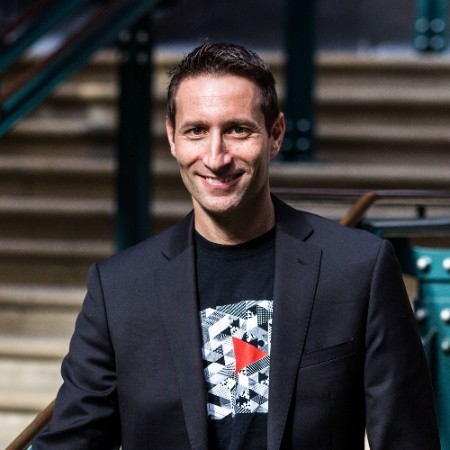 In this week’s member guest blog post we caught up with Nadav Perry, VP Global Brands & Agencies at Taboola. In this all-inclusive piece Nadav looks at supply path transparency in video ads. For more on what he thinks are the key challenges and how we can move past them, keep reading.
In this week’s member guest blog post we caught up with Nadav Perry, VP Global Brands & Agencies at Taboola. In this all-inclusive piece Nadav looks at supply path transparency in video ads. For more on what he thinks are the key challenges and how we can move past them, keep reading.
If you’re in the advertising world, you’re probably familiar with the quote widely attributed to US Retail Magnate John Wanamaker who claimed that; “Half my advertising spend is wasted; the trouble is, I don’t know which half.”
Surprisingly, in the digital advertising world of 2023 despite all the technology advancements, attribution capabilities and ability to measure almost every step of the supply path, this quote is not only still valid, it’s a major pain point for most advertisers. In fact, the digital distance between advertisers and their end customers is not showing any signs of shrinking and many are still unable to account for much of their spend across the media supply path.
Supply Path Optimisation (SPO) is a daily challenge for media buyers trying to streamline and monitor their media supply path. The question of what exactly is the nature of what they’re buying remains unanswered for even the most savvy advertiser. But how can you optimise if you don’t even have visibility into the supply path? Supply Path Authenticity - transparency around where and how ad dollars are being spent - is crucial for media buyers looking to reduce costs, improve performance and maintain quality.
One example of this phenomenon is video advertising. Traditionally, video ad placements on the open internet were divided between instream and outstream. Instream was widely regarded as a more desirable type of ad content because of the expected user experience and intent to watch. Without definitive guidelines, many video ad platforms classified their video ads as instream when in fact they’re far from it, and in many cases it’s hard to tell if users are even paying them any attention.
Every advertiser dreams of the ultimate video experience - brand safe, viewable, users with high intent… But the reality is supply that’s very diverse, with varying formats, characteristics, settings and environments, makes it hard for advertisers and media agencies to know exactly what they’re getting.
In an effort to help advertisers better understand what they’re spending their video ad dollars on, add transparency to the supply chain and improve user experience, IAB TechLab released updated guidelines for new definitions of video ad placements. The new guidelines define ‘instream’ as “Pre-roll, mid-roll, and post-roll ads that are played before, during or after the streaming video content that the consumer has requested. Instream video must be set to “sound on” by default at player start, or have explicitly clear user intent to watch the video content. While there may be other content surrounding the player, the video content must be the focus of the user’s visit”
We’re already seeing a shift in the balance between instream and outstream with advertisers pushing for adoption of these new guidelines. In fact, with the updated definition, only 10% of video content is expected to be classified as instream.
The remaining 90% of video content will be classified in a number of tiers of outstream and for many video advertising platforms this means a significant change having classified their video content as instream regardless of whether it was ever watched. Not only will they not be able to call their video placements ‘instream’ anymore or have access to advertising demand that proactively targeted instream supply - they will not be able to charge advertisers a higher premium for it.
But for some video advertising platforms the change is a welcome one - companies like Taboola who have focused mainly on outstream. Not all outstream is created equal and Taboola has spent recent years perfecting the tech and know-how to provide outstream video that drives business results. Unlike most platforms, Taboola’s unique technology powers the organic, editorial and advertiser experience on publisher sites which means direct access to the page on which the video ad is played. The result is sophisticated contextual and audience-based data providing advertisers with advanced context and targeting capabilities, placement on the world’s top publisher sites and brand safety. In other words - Premium Outstream.
Moreover, in a recent study, Kantar found that Taboola native outstream videos increased user awareness, favourability and engagement. Among others, the study showed that more people watched the whole ad in both the social and streaming platform after also being exposed to native ads. And more viewers enabled audio on the social platform after they were exposed to native ads.
In the video advertising supply path, experts agree that IAB TechLab’s updated guidelines will create a much smaller video advertising tier of ‘true instream’ but they will also take advertisers one step further in their understanding of outstream supply and their ability to see beyond the general in and out stream definition, focusing on other attributes that give video placements true value.
The evolution of video advertising is far from over but with these new guidelines, media buyers have better visibility and transparency when it comes to where they’re spending their video dollars and what they’re really getting for them. While many media agencies are trying to promote SPO initiatives, some market leaders are ready to go beyond SPO and start tackling SPA (Supply Path Authenticity) where the question of video supply authenticity will no longer be left unanswered.

At the end of 2022, we created a new Retail Media Working group that aims to bring stakeholders from across the Retail Media ecosystem together to facilitate collaboration, provide education, insights, and create standards. Currently, however, there are no standards for Retail Media in existence, so the group is exploring what should be tackled and then prioritised in this area.
We therefore wish to invite those involved in the buying or selling of Retail Media to share what is hindering further investment and what areas are in need of standardisation, whether that be metrics or measurement or creative specifications. If you are a buyer, seller or ad technology provider, please share your views in this short survey and feel free to pass on to your colleagues as well.
Completing the survey will take no more than 5 minutes of your time and will help us to support and shape the future of Retail Media in Europe. The deadline to complete the survey is Friday 11th August and rest assured that your response will remain strictly confidential.
With summer in full swing and the end of H1 here, we look back over the last six months to celebrate all the best bits and the great work we have achieved with our wonderful members.
A huge thank you to everyone involved, for your hard work, support, and continued commitment to sharing your expertise.
Events
Our focus for H1 centred on our new work tracks Sustainability and Retail Media, alongside key outputs from the Programmatic Trading Committee on Omnichannel and Brand Advertising Committee on In-Gaming. Our Great Debate series was a great success with a hybrid event in partnership with Taboola on Retail Media and a virtual event diving into sustainability across three panels. We also held our first hybrid Virtual Programmatic Day in partnership with Xaxis in May, where we covered topics such as Omnichannel and AI. Finally, we were thrilled to see so many of our members gather tp hear insightful keynote presentations and panel discussions at our flagship event Interact in Madrid in May which was a great success.
Catchup on our event recordings from H1 below
Guides, Insights & Industry Leading Research
Along with our committees and fantastic members, we have put together educational and insightful outputs for the industry. Click below to dive into these pieces.
Policy, Advocacy & Legal
During the first half of 2023, our Policy Committee established the DSA Ads Transparency Taskforce to discuss the implementation of Article 26 of the Digital Services Act (DSA) concerning ads transparency requirements.
The Committee also produced the European Media Freedom Act (MFA) position paper, which primarily focuses on audience measurement, specifically Article 23 of the MFA.
Regarding the Data Act, two joint industry open letters have been issued on the Data Act, one initiated by FEDMA addressing LIBE MEPs and another initiated by IAB Europe during the start of trilogue negotiations. These letters highlighted our concerns about the conflicts between the Data Act and the GDPR.
We have also been actively participating in the European Commission's work on the Cookie Pledge and the Fitness Check on consumer law. The Policy Committee is currently preparing its advocacy strategy for the upcoming 2024 EU elections.
What’s on the Horizon for H2 2023?
As we head into the second half of 2023, you can expect more great content, insights, and exploration from us and all our members. We will be focusing our efforts on the hugely important topics of Sustainability and Retail Media and will be diving further into Omnichannel, DOOH, and Audio. We’ll also bring you even more great events including our second Virtual Programmatic Day, our Great Debate on Trust & Transparency, and our Virtual CTV event to name a few.
If you’d like to get more involved with our Committees & Task Forces and the great work that we produce at IAB Europe, please reach out to the team at communication@iabeurope.eu.
We look forward to our continued collaboration with you all.
IAB Europe’s Widely-Anticipated 2022 AdEx Benchmark Report is Now Live!
Released on 13th July 2023, the report is the definitive guide to advertising expenditure in Europe covering 29 markets. It details the formats and channels that contributed to digital advertising’s annual growth of 9.8 percent in 2022, culminating in a total market value of €86bn.
You can read the full report here.
If you’re looking for key facts, stats, and highlights, then check out these short videos, featuring our very own Chief Economist, Daniel Knapp:
Are you ready to dive into the ever-evolving world of programmatic advertising? We're excited to invite you to take part in the latest Attitudes to Programmatic Advertising Survey and help us uncover valuable insights.
Whether you're an Advertiser, Agency, Ad Tech company, or Publisher, your perspective is crucial in understanding the current state of programmatic adoption across Europe. Your input will shape the industry's future.
Now in its ninth year, the study is an industry benchmark to show how programmatic advertising attitudes, adoption, and strategies are evolving, and you can access last year's report here.
The survey will only take a few minutes of your time, and the deadline to participate is Friday 11th August. As a token of our appreciation, you also have the opportunity to enter a prize draw. If you win, you will have the chance to select a charitable cause where we will make a donation of two hundred euros on your behalf.
Rest assured, your responses will be treated with confidentiality. Plus, as a thank-you gesture, we'll send a complimentary copy of the comprehensive 2023 report, providing a deep dive into the survey results to those that wish to receive it.
But we also need your help to spread the word! Last year’s survey received over 1K respondents and we are keen to keep up this momentum to drive the research forward. Share the survey with your colleagues and networks, and let's gather a diverse range of perspectives. Together, we can shape the future of programmatic advertising.
The top-level results will also be shared at DMEXCO 2023 so industry stakeholders can see the trends and developments shaping the European programmatic industry.
Don't miss out on this opportunity to make a difference. Join us in shaping the industry's future by participating in the survey today!
Dated: 05 October 2023
Important note: The Implementation deadline of TCF v2. has been moved from September 30th 2023 to November 20th 2023. More information here.
In order to respond to the changes and needs of the market, while continuing to help players in the online ecosystem comply with certain requirements of the ePrivacy Directive and the General Data Protection Regulation (“GDPR”), the Transparency and Consent Framework (“TCF”, “Framework”) needs to be updated on a regular basis. In particular, constant evolutions in case law as well as in guidelines of Data Protection Authorities (DPAs) place ever higher demands on market participants in terms of data protection requirements. The TCF instances have therefore drawn inspiration from them to bring new iterations to the Framework. In addition, some changes are related to the Action Plan submitted to and validated by the Belgian Data Protection Authority (more information here).
IAB Europe, in partnership with IAB Tech Lab, is committed to continuous improvement and development of the Framework through industry collaboration to meet the needs of users and regulators. The iterations brought by the TCF v2.2 aim to bring further standardisation of the information and choices that should be provided to users over the processing of their personal data, and to how these choices should be captured, communicated and respected.
TCF v2.2 will be launched mid-May and TCF participants will have until the end of Q3 2023 to make the necessary changes to their respective implementations. All iterations have been developed to avoid breaking changes to the existing v2.1 Technical Specifications and facilitate their adoption in a timely manner by CMPs and Vendors.
To help the market anticipate these upcoming changes, this article provides an overview of the different amendments to the TCF Policies and Technical Specifications. In the run up to the launch of TCF v2.2, IAB Europe is hosting a series of webinars to offer full support and guidance to CMPs, Vendors and Publishers. Recording of previous webinars can be found at the end of this blogpost.
1) Removal of the Legitimate Interest Legal Basis for Advertising & Content Personalisation
The current version of the TCF Policies allows the use of legitimate interest or consent to carry out data processing operations for Purposes 3 (Create a personalised ads profile), 4 (Select personalised ads), 5 (Create a personalised content profile) and 6 (Select personalised content). The TCF Policies will be amended to remove “legitimate interest” as an acceptable legal basis for these Purposes. As a consequence, within the scope of the TCF, Vendors will only be able to select consent as an acceptable legal basis for these Purposes at registration level.
2) Improvements to the Information Currently Provided to Users in CMP UIs
The Purpose names and descriptions will change. CMPs will be required to present improved user-friendly descriptions, replacing the current user-friendly text as well as the (currently) mandatory legal text. CMPs will also be required to make available illustrations based on real-use cases, which aim to explain to users how TCF Participants’ data processing operations relate to the Purposes.
In order to improve transparency over the means of processing used by Vendors in support of the TCF purposes, Vendors will be able to declare additional features at registration level.
3) Standardisation of the Additional Information About Vendors Provided to Users in the Secondary Layers of CMP UIs
To provide greater transparency, Vendors will now be required to provide additional information about their data processing operation at registration level - so that this information can in turn be disclosed by CMP to end-users in secondary layers UIs.
The new TCF Policies will include a standard taxonomy of categories of data, from which a Vendor can select from at registration level. The Policies will include a new UI requirement for CMPs to disclose for each Vendor the categories of data collected and processed.
Vendors will be able to declare, at the time of registration, how long (in days) they keep data for each declared purpose. Accordingly, the new TCF Policies will include a new UI requirement for CMPs to disclose for each Vendor how long they keep data to achieve each declared purpose.
Vendors will be required to declare what their legitimate interests at stake are, by providing at the registration level a dedicated URL where with this information can be found (e.g. a bookmark of their existing privacy policy). The amendment to the Policies will require CMPs to make this information available to users through the secondary layers of their UI.
Vendors will be able to declare during registration differentiated URLs to their privacy policy or legitimate interest statement for each TCF-supported language, where available. Publishers and their CMPs will have the option as a result to direct users to Vendors’ privacy documentation in the relevant language to improve transparency for users.
4) Greater Transparency for Users About the Number of Vendors
CMPs will be required to disclose on the first layer of the CMP UI the number of third-party Vendors that are seeking consent or pursue data processing purposes on the basis of their legitimate interests. The TCF Policies do not impose any specific maximum number of Vendors, but Publishers are strongly encouraged to ensure that they only work with Vendors that are (most) relevant to them. The TCF Policies will include a warning that an unjustifiably large number of Vendors may impact users’ ability to make informed choices and increase Publisher and Vendor legal risk.
To assist Publishers in the process of selecting the Vendors for which they establish transparency & consent, an additional Vendor Information List has been published (“B2B GVL”). It contains information that can make it easier for a Publisher to determine which Vendors are relevant for it. Information contained in the B2B GVL can be used by Publishers to, for example, avoid requesting user’s consent for Vendors that operate in technical environments and jurisdictions that are not relevant to their online services, as well as generally better understand each TCF Vendor’s scope of operations and whether it transfers data outside of the EEA.
5) More Specific Requirements to Facilitate Users’ Withdrawal of their Consent
Publishers and their CMPs will be required to ensure that users can re-access the CMP UI easily to manage their choices (e.g. from a floating icon or a footer link available on each webpage, or from the top-level setting of the app).
If the initial consent request presented to users contains a call to action that enables user to consent to all purposes and vendors in one click (such as “Consent to all”), an equivalent call to action should be provided when users re-access the CMP UI to withdraw consent to all purposes and vendors in one click (such as “Withdraw consent to all”).
Additionally, the TCF Technical Specifications will mandate Vendors (rather than only recommending) to use event listeners to ensure that any changes to TC Strings are proactively communicated to them and other Vendors. In the web environment, Vendors with access to Javascript will be required to register an event listener function (addEventListener) instead of using the getTCData command of the TCF API. In the app environment, Vendors must listen to IABTCF_* key updates to retrieve TC Strings from NSUserDefaults (iOS) or SharedPreferences (Android).
6) Enhanced TCF Compliance Programmes
Since 2019, IAB Europe has developed Compliance Programmes to verify compliance of TCF Participants with the Policies and Technical Specifications. These programmes will be expanded, with new auditing mechanisms and differentiated enforcement procedures.
All auditing mechanisms and verifications susceptible to be performed in the context of the TCF Compliance Programme will be described and published in a public Control Catalogue, to help TCF participants in assessing and reviewing the compliance of their TCF implementations. In addition to the Control Catalogue, IAB Europe will release a new version of the CMP Validator Chrome Extension that will be publicly available.
IAB Europe will increase the volume of proactive auditing of CMPs and Vendors that will be randomly selected each month, and will also act upon reports of non-compliance from the market or from end-users by making available a dedicated form to submit a complaint.
Vendors and CMPs will be subject to differentiated procedure according to the nature of the non-compliance. In particular, any tampering with or falsification of TC String will result in immediate suspension from the Framework for a minimum of four weeks, and will be notified publicly.
7) Reminder: Revocation of the consensu.org Subdomains
Support for Global-scope was deprecated in June 2021 due to negligible use by Publishers (less than 0,5%) and compliance considerations. The deprecation required CMPs to delete all existing euconsent-v2 cookies associated with the consensu.org domain. IAB Europe will now remove all consensu.org subdomain delegations to CMPs’ nameservers (which had previously been provided upon registration). As a result, CMPs will no longer be able to host their scripts on their consensu.org subdomain, and this in turn technically prevents them from setting and accessing cookies on the consensu.org domain.
CMPs currently hosting their scripts on their consensu.org subdomains will need to host them on a different domain. Their Publisher clients will need to redeploy a new script on their digital properties before July 10th (see notification here).
How Should TCF Participants Prepare ?
Changes to the TCF Technical Specifications
The changes to the TCF technical specifications are open for public comment until May 12th, 2023 and can be found here. Comments may be submitted via email to transparencyframework@iabtechlab.com. The technical changes included in TCF v2.2 are also outlined in IAB Tech Lab's blog post here.
Support Workshops for TCF Participants
Hosted in 1 hour-long webinar formats, TCF experts went through everything that is needed to fully implement TCF v2.2. All webinars featured Q&A sessions and have been recorded.
[Video Recordings]
Session 1: Overview of the main differences between the TCF policies 3.5 & 4.0
An overview of the main differences in policies between v2.1 & v2.2. This session is for all TCF stakeholders. Watch the recording here.
Session 2: Overview of the changes to the TCF technical specifications between v2.1 & v2.2
An overview of the changes to the TCF technical specifications between v2.1 & v2.2. This session is to help CMPs and Vendors navigate the different technical resources. Watch the recording here.
Vendors
Webinar recording to give an overview of the changes for Vendors implementing the TCF can be watched here and the presentation deck can be downloaded here.
CMPs
Webinar recording to give an overview of the changes for CMPs implementing the TCF can be watched here and the presentation deck can be downloaded here.
Publishers
Webinar recording to give an overview of the changes for Publishers implementing the TCF can be watched here and the presentation deck can be downloaded here.
CO₂ Emissions in the Digital Advertising Supply Chain: Call for Proposals to Complete a Measurement Framework Mapping & Gap Analysis
IAB Europe wishes to engage an external contractor with expertise in environmental sustainability and the digital advertising ecosystem to develop thinking and research around the measurement of CO₂ emissions generated by the delivery of digital advertising products. The initial brief is to undertake an analysis of the measurement and methodology landscape for carbon emissions in digital advertising activation, mapping out all existing methodologies and providing an analysis of each of them in relation to their stage of maturity and their potential suitability as a starting point for a single, unified pan-European framework. Based on satisfactory completion of this gap analysis, the role could evolve into a permanent part-time support to the Association’s environmental sustainability work-track.
The role is an initial short focused project with a proposed duration of 8 weeks leading into a long term engagement to support the development of standardisation and frameworks the measurement of Co₂e emissions produced by the delivery of digital advertising and requires a sustainability supply chain expert who has a comprehensive understanding of the digital landscape and an awareness of the digital advertising ecosystem.
The role will require the individual to present the findings back to the internal IAB Europe team and also the IAB Europe ESG Methodology and framework workgroup.
Key Deliverables (8 week project):
Project Proposed Timeline:
Long term engagement:
Additional Experience & Qualifications:
The ideal candidate will have previous experience in a similar role and possess the following criteria:
Location, compensation:
To apply, please submit your resume and a cover letter explaining your interest in the position to Lauren Wakefield - wakefield@iabeurope.eu.
We appreciate all applications, but please note that only shortlisted candidates will be contacted for an interview.
IAB Europe is an equal opportunity employer and welcomes applicants from diverse backgrounds.
On 23rd-24th May we hosted our annual flagship event Interact in Madrid, where we brought leaders from across the digital advertising and marketing ecosystem together to discuss and debate the hottest industry topics of the moment.
Thanks to the support of our sponsors and media partners, and the wonderful team at IAB Spain, we enjoyed two days of keynote speeches, panel discussions and networking under the central theme of ‘Innovation, Sustainability & Growth’.
Check out the highlights video here and event images here.

We unpacked a wide variety of topics as we looked to help the digital advertising industry become privacy first, tackle sustainability, and drive growth through innovation. From the latest ad spend figures, Retail Media, CTV, the attention economy, and trust, to premium publisher’s advertising models, sustainability, policy and more no stone was left unturned as we uncovered everything essential in our industry today.
Thanks so much to everyone who joined us and thank you to all of the amazing speakers who came together from across Europe and beyond to share their insights and expertise. With over 240 people joining over the two days, we are delighted to call it a great success.
If you didn’t have the opportunity to join us or did and want to relieve all of the great content, in this post you will find links to all of the highlights, including session overviews, as well as video recordings for you to view in your own time.
Event Highlights
Interact 2024 – Stay Tuned!
We hope you will be able to join us next year! Stay tuned for the reveal of the next location and get ready to pop the date in your diary as we prepare for Interact 2024.
In the meantime, if you’d like to know more about IAB Europe or how you can get involved in Interact 2024 please do reach out to communication@iabeurope.eu
On 23rd-24th May we hosted our annual flagship event Interact in Madrid, where we brought leaders from across the digital advertising and marketing ecosystem together to discuss and debate the hottest industry topics of the moment.
Thanks to the support of our sponsors and media partners, and the wonderful team at IAB Spain, we enjoyed two days of keynote speeches, panel discussions and networking under the central theme of ‘Innovation, Sustainability & Growth’.
Check out the highlights video here and event images here.
On day two, we focused our attention on policy and putting things into practice. From the latest updates on the DSA and the TCF to performance marketing, sustainability and premium publisher advertising models, we uncovered everything that is vital to our industry today.
If you missed it or want to catch up on everything from day two, you can find an overview of each session, key takeaways, and video highlights right here.
Welcome & Opening Remarks from IAB Ukraine
Our colleague Anastasiya Baydachenko, CEO of IAB Ukraine gave a highly inspiring opening keynote on the latest updates and importance of the situation in Ukraine.
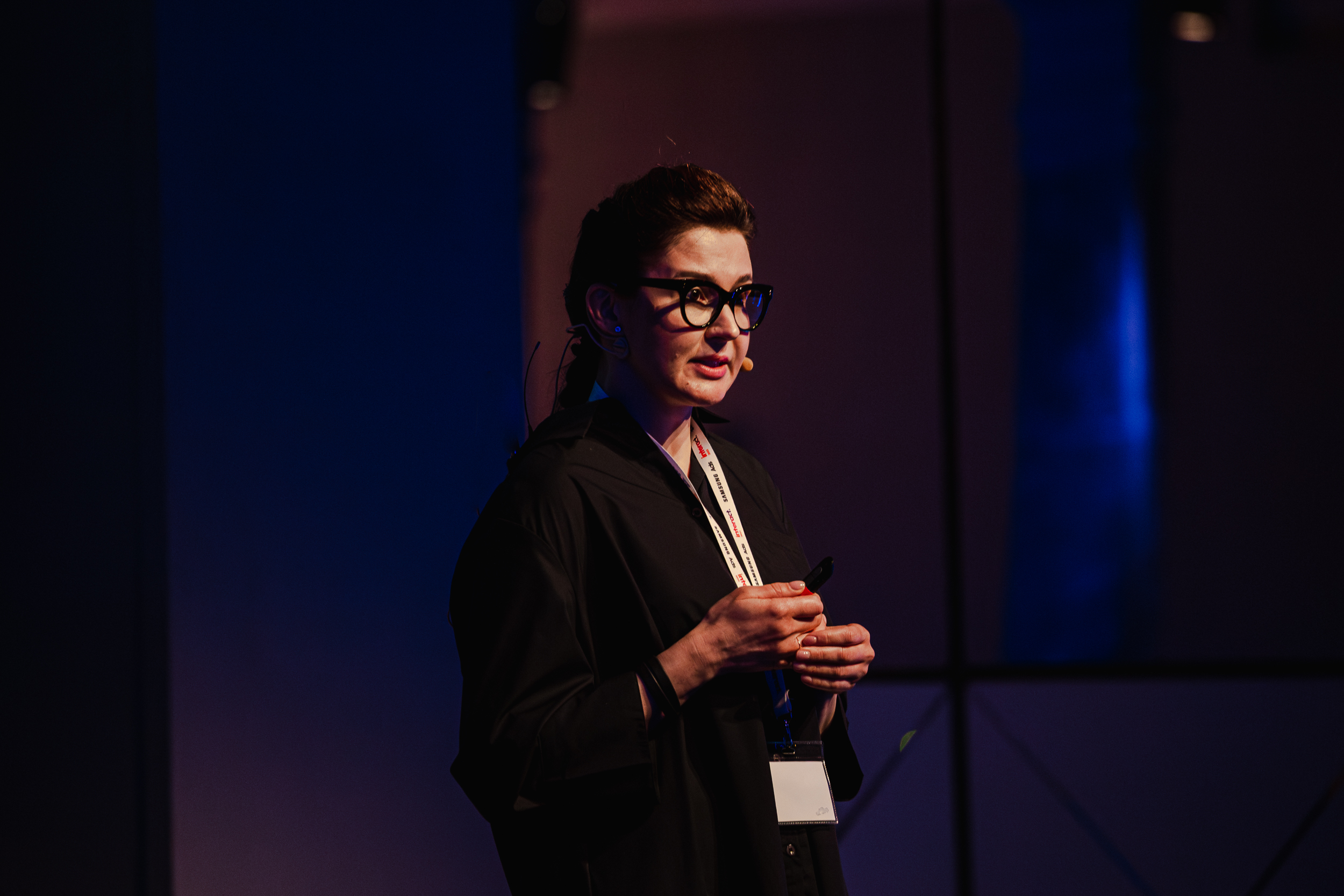
What You Need to Know About the DSA Today
In this informative panel discussion Inés Talavera de la Esperanza, Public Policy Manager at IAB Europe led a key conversation on the latest updates on the DSA and the importance of what we need to know and do as an industry today. Inés was joined by:

The Latest Updates on the TCF
In this panel discussion, industry experts came together to discuss the latest updates with the Transparency & Consent Framework (TCF) v2.2. They discussed the benefits of the latest version of the TCF, how it has been developed, the key challenges that need to be addressed and what’s next for the framework.
Ninon Vagner, Privacy Director at IAB Europe moderated this session as was joined by:

Redefining Performance. Agility and Fluidity Across Channels
Just what is a simplified route to growth? Dave Hompe, VP at GroupM Nexus EMEA and Sara Terol, Search & Programmatic Senior Manager at Melia International Hotels took to the stage to discuss the importance today of a holistic, full-funnel approach to media plans.

Sustainability in Digital Advertising
In this panel discussion, industry experts came together to discuss the state of readiness of our industry when it comes to sustainability. They explored what is available today to help drive the reduction of carbon emissions produced by the delivery of digital advertising and took a look into what else needs to be done in order to achieve sustainability in our industry.
Claire Gleeson-Landry, Head of Investment & Sustainable Media at Good-Loop moderated this session and was joined by:
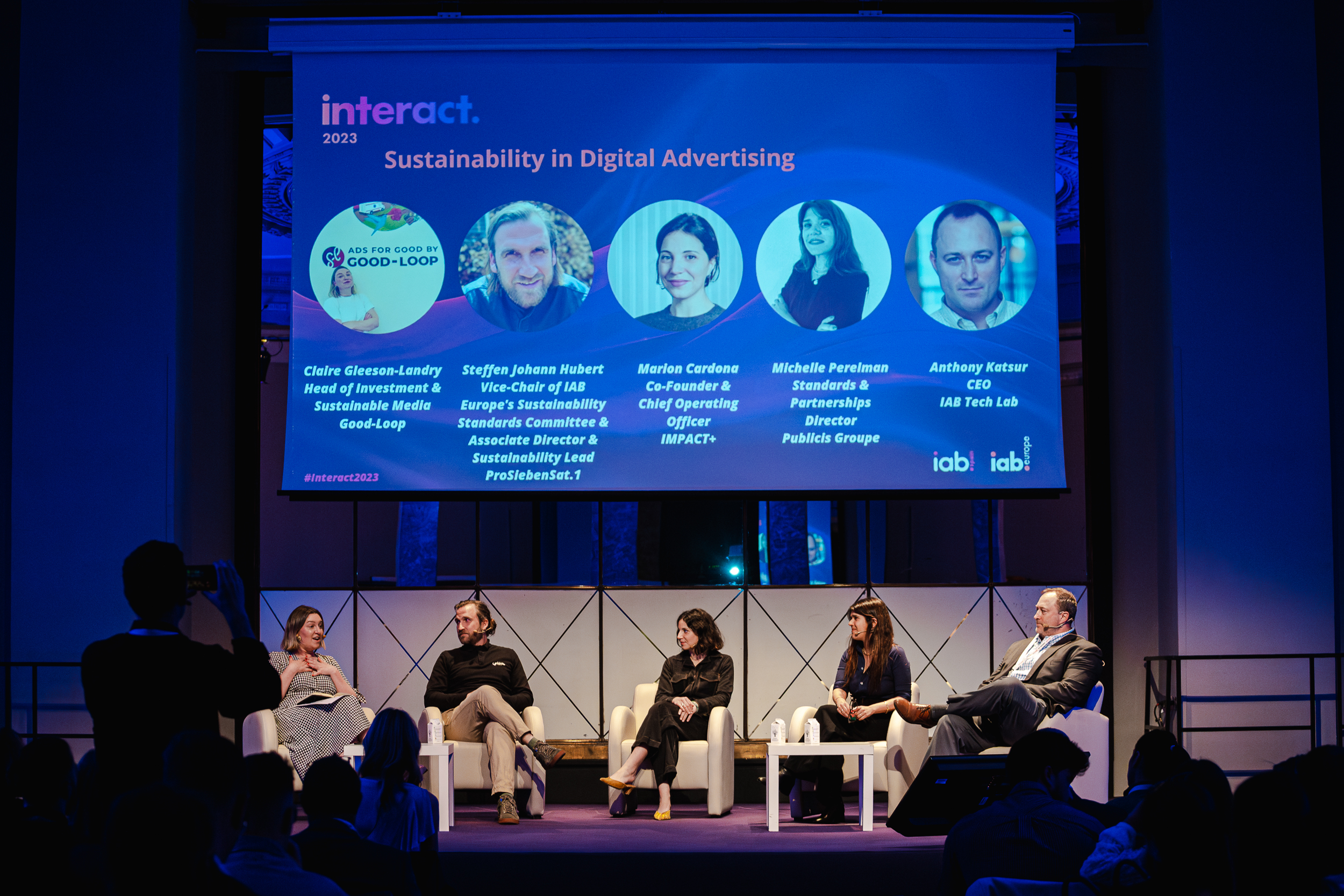
The Future of Video Across Europe
The concept of Connected TV has become a widespread topic. While transparency isn’t a new concept, it’s one that continues to evolve - especially as digital channels like CTV experience tremendous growth. With any large-scale growth, challenges tend to appear and this is the crossroads we are experiencing in CTV today. Augustin Decré, Index Exchange’s Regional Managing Director SEMEA walked us through the future opportunities CTV represents in Europe.

A Premium Publishers View on Advertising and its Changes
In this short presentation, Robert Blanck, General Manager eCommerce & Advertising at Axel Springer ran through the challenges of being a premium publisher. From the strategic question of the right balance between paid and advertising revenue, through to the current ecosystem challenges of addressability, first party data and contextual, to the question of what a healthier ecosystem can look like and what role publishers can play in it. He also looked at industry standards and alliances and how they will shape the future for publishers.

Premium Publisher Advertising Models: Update and Outlook
How are premium publishers evolving their advertising business models? This panel dived into data strategies as well as innovations in areas such as programmatic trading, contextual, branded content, e-commerce, and partnerships.
Joanna Burton, Chief Strategy Officer at ID5 and Interact 2023’s host moderated this session and was joined by:

On 23rd-24th May we hosted our annual flagship event Interact in Madrid, where we brought leaders from across the digital advertising and marketing ecosystem together to discuss and debate the hottest industry topics of the moment.
Thanks to the support of our sponsors and media partners, and the wonderful team at IAB Spain, we enjoyed two days of keynote speeches, panel discussions and networking under the central theme of ‘Innovation, Sustainability & Growth’.
Check out the highlights video here and event images here.
On day one, we focused our attention on the trending topics of today. We tackled a whole host of industry challenges, opportunities and aspirations. If you missed it, not to worry, here you can find an overview of each session, key takeaways and video highlights.
AdEx Benchmark 2022 - The Latest European Digital Advertising Expenditure Insights
We opened Interact 2023 with a keynote presentation from our Chief Economist, Daniel Knapp around the latest AdEx Benchmark Study results.
IAB Europe’s AdEx Benchmark report is the definitive guide to the state of the European digital advertising market. Daniel Knapp unpacked the channels and formats that contributed to the digital advertising market value in 2022.
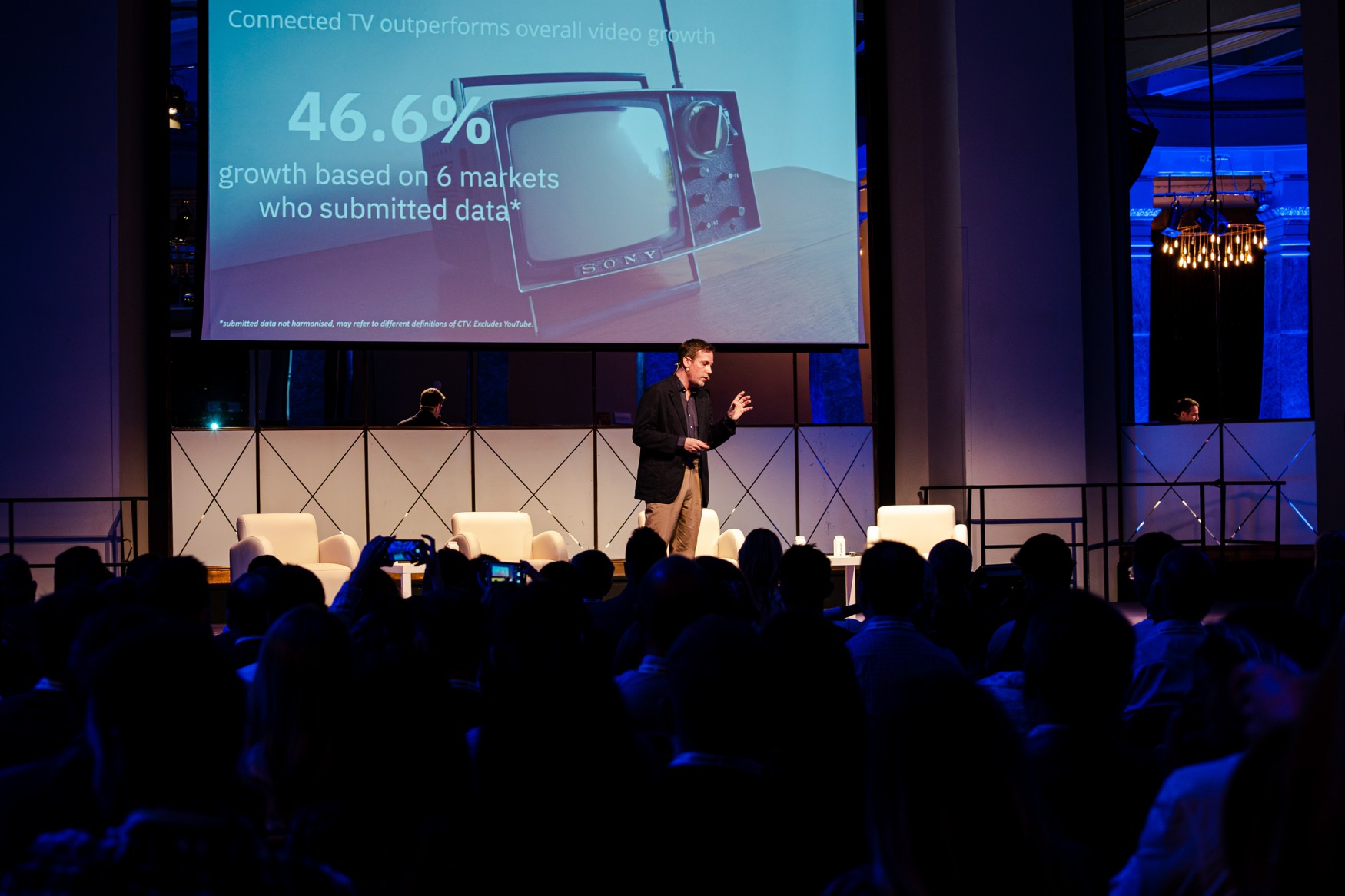
European Leaders Discussion on the Digital Ad Spend Insights
Following the opening keynote presentation, a panel of European leaders discussed and debated the latest AdEx Benchmark results and shared some of their own thoughts and predictions for the year ahead.
This session was moderated by Hannah Bowler, Senior Reporter at The Drum who was joined by:
Read ‘The Drum’s’ write-up of the session here
Resetting the Bar on Brand Communication
In this keynote session, Taide Guajardo, Brand Senior Vice-President, Europe at P&G discussed how in today’s world, full of challenges but also opportunities, it is time for our industry to not just raise, but rather reset the bar on serving the consumer with Superior Communication that delivers Growth and creates Value.
She shared insights on how Brand Communication can step up to better understand the people we serve, reach them more effectively and efficiently, and be inclusive and purpose-driven.

The Retail Media Opportunity
Alexis Marcombe, Managing Director at Carrefour Links took the audience through a Retail Media 101. He shared what Retail Media is, the kind of opportunity it represents today and gave an exclusive insight into what Carrefour plans to do with its new joint venture with Publicis.

Revolutionising TV Advertising: Unlocking Efficiency and Agility for the Digital Age
Tom Peruzzi, Spokesman of the Executive Board & CTO at Virtual Minds (ProSiebenSat.1) discussed how in today's fast-paced digital age, linear TV campaigns can no longer rely on the classic pre-planning model. With the market demanding shorter lead times and comparable KPIs to digital channels, the convergence of digital and linear TV is revolutionising the industry. He showed us how to unlock efficiency and transform TV advertising in this new landscape.
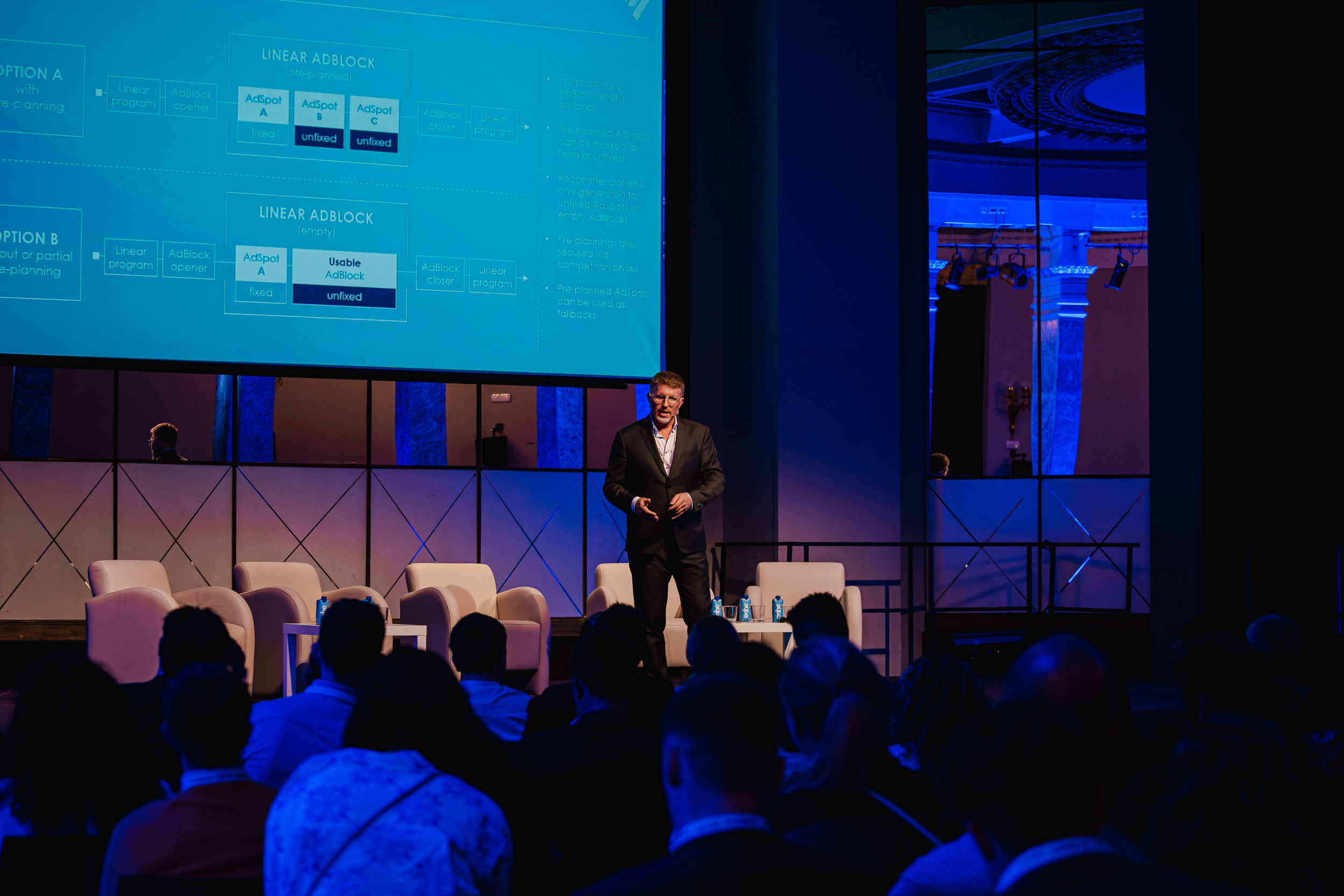
Streaming TV’s New Era: How Ads Are Powering Streaming’s Future in the EU5
Alexandra Ong, Business Development Director at Magnite too us on an in-depth look at how advertising is driving the future of streaming in the EU5. As EU5 viewers prefer ad-supported streaming to traditional television, brands can engage with addressable audiences with ever-increasing reach and scale. The cross-device viewing habits of the EU5 audience influence purchasing decisions and advertising impact. This presents advertisers with an excellent opportunity to increase their brands' visibility and create stronger connections with consumers. Magnite presented its latest study, Streaming TV's New Era, which looks at the viewer behaviour driving this change.

Connected TV (CTV): The State of Play in Europe Today
We are now entering an Advanced TV universe with CTV revolutionising how European audiences consume TV. Now is the time for advertisers to take advantage of this impactful medium and carefully plan, optimise and measure campaigns. In this panel discussion, industry leaders discussed the current challenges and opportunities for CTV in Europe. They dived into and debated measurement and shared best practices to tap into this exciting channel.
Vincent Flood, Founder & Editor-In-Chief at VideoWeek moderated this session and was joined by:

The Power of Attention - Heineken Metacase
Attention measurement continues to demonstrate that this new wave of media research is helping advertisers drive better business outcomes compared to legacy metrics. But what does attention measurement look like in action? What happens when you take attention measurement from the lab to the wild?
Teads has been putting attention measurement into action for the past 12 months. As such Phil Sumner, VP Global Research Operations at Teads shared some of their learnings, together with Peter Maxwell, Global Media Lead, The Heineken Company.
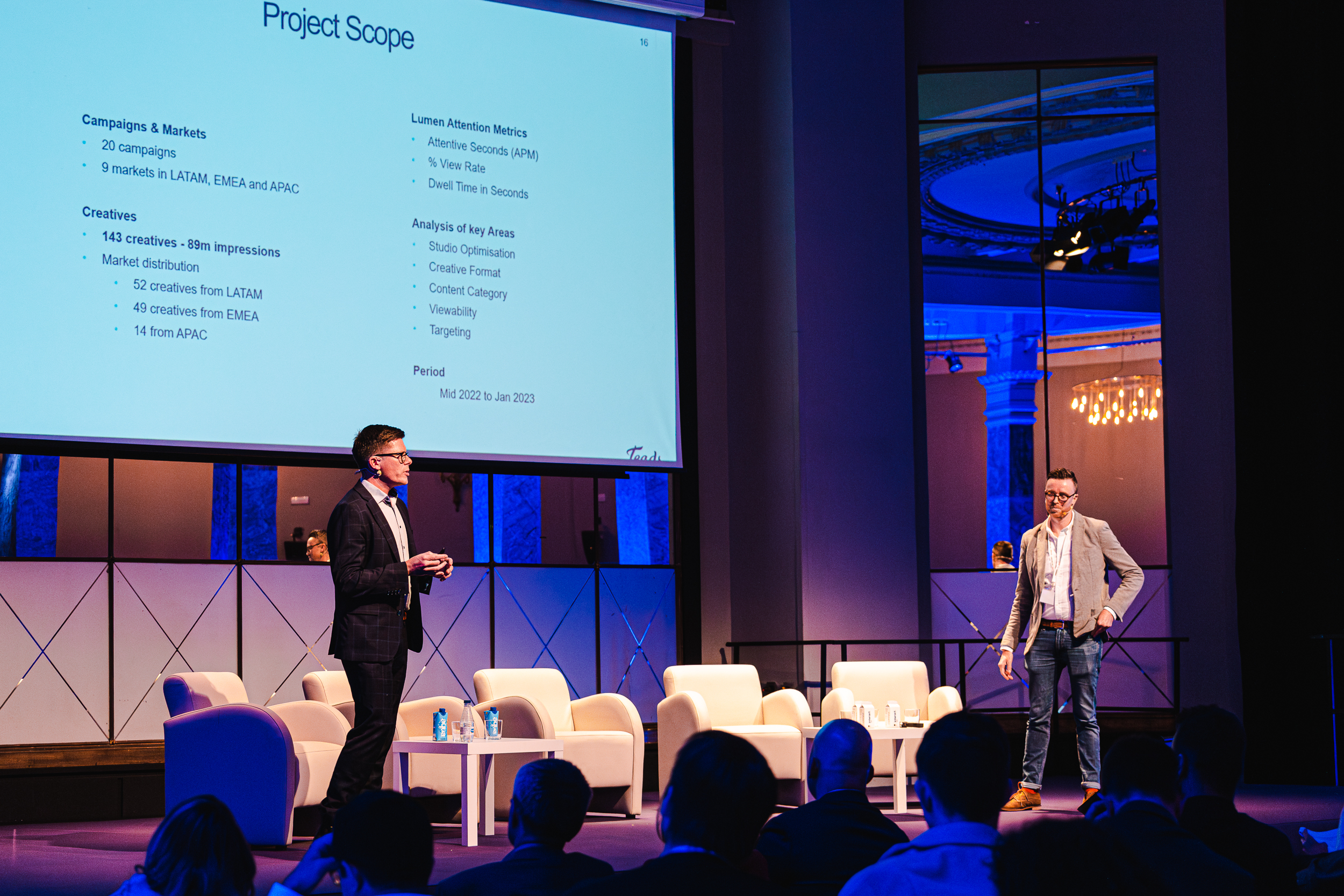
Attention Pays: The Value of Attention in Digital Advertising
The attention economy is critical for brands looking to really understand how their campaigns engage an audience at a granular level. It’s the currency of the moment, and on the tip of everyone's tongue when it comes to priorities for 2023. But why are we so invested in attention today? How does it work, how is it measured and what is its real value?
In this panel discussion industry experts came together to answer these questions and more. They looked at why attention is so important to digital advertising in Europe today and shared best practices to make the most out of this much-talked-about currency.
Andy Brown, CEO at The Attention Council moderated this session and was joined by:

Trust & Transparency: The Future of Responsible Marketing
In this keynote presentation Michael Todd, Global Director of Industry Relations at Google discussed how consumers are losing trust in the digital marketing ecosystem and that we need to come together to put responsible marketing and privacy at its core to make digital advertising safer for consumers, successful for publishers, and more impactful for businesses.
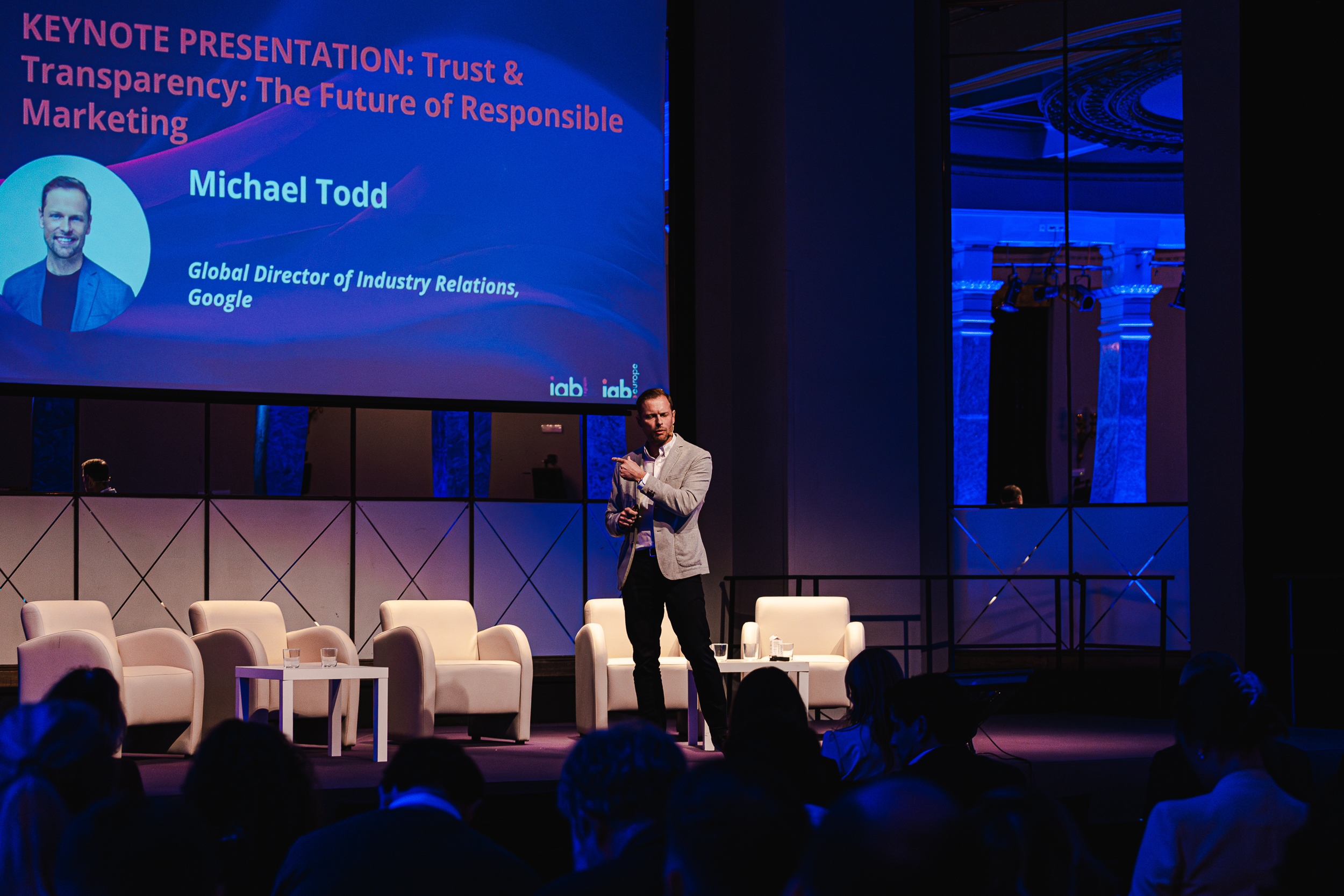
Leading the Digital Advertising Industry into a New Era of Trust & Responsibility
Digital advertising is an integral part of the European economy. Our industry is at the forefront of technology innovation and creativity, building digital products, ensuring media pluralism and enabling consumer choice.
But the industry has fallen short of creating a trusted and credible environment towards policy makers and civil society on how it operates. IAB Europe’s Industry Leadership Council (ILC) was conceived in response to this realisation. It brings together actors across the advertising ecosystem to build a bridge to policy makers for an open and constructive dialogue.
Our closing panel of the day discussed what is currently being done in the ILC and what else is required to ensure a sustainable future for the industry.
Townsend Feehan, CEO at IAB Europe moderated this session and was joined by:
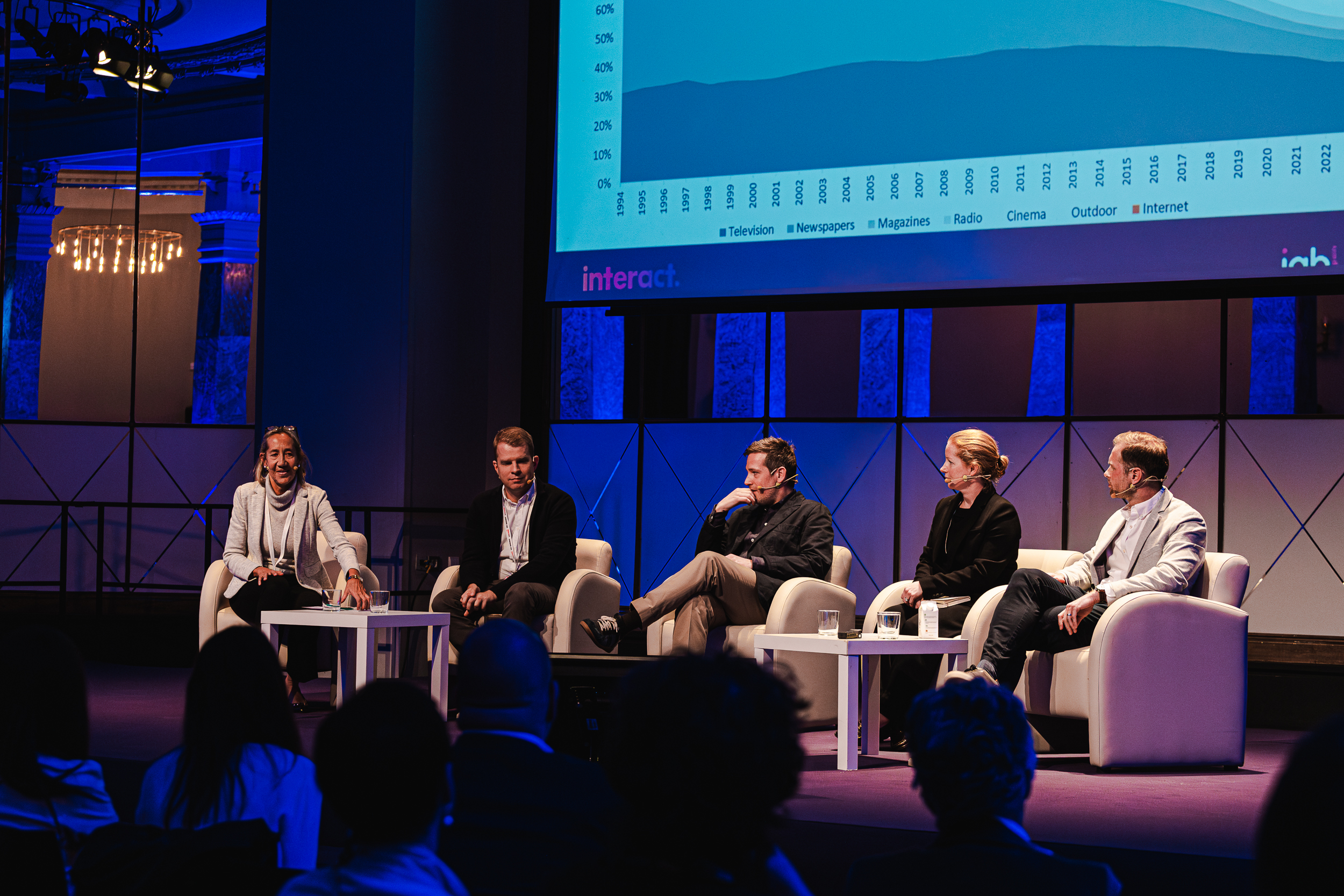
This week’s member guest blog post is from Ilhan Demir, Academy Manager at IAB Turkey, who discusses his experiences of day one of our very own Flagship event Interact in Madrid. He shared his key highlights and takeaways of the event. Read below to learn more.
IAB Europe’s Annual Flagship Event Interact was held between 23rd - 24th May 2023 in Madrid for the second time, with the theme of ‘Innovation, Sustainability & Growth’.
Here are my notes about the event, I hope you enjoy reading!
AdEx Benchmark 2022 Report “Under the Shadow of Inflation”:
AdEx Benchmark Report, which is Interact’s most anticipated session and the opening keynote every year, was announced again this year by IAB Europe’s Chief Economist Daniel Knapp. Although Türkiye has been facing high inflation for a while, the inflation problem was also highlighted on the agenda of other European countries.

According to the report, European Digital Advertising Investments reached 86 billion Euros in 2022 with a growth of 9.8%. Among 29 countries, Türkiye has the highest growth of 93.3%. When we look at the data adjusted for HCPI, Türkiye is still number one in growth ranking and has the highest growth rate (CAGR) for 3 years at 41.5%.
At last year's conference, the growth forecast for 2022 was announced as 10.1%. According to Daniel Knapp's forecast, total Digital advertising investments are expected to be 90.1 billion Euros, with a growth of 4.8% for 2023.
You can find the report highights here.
Accessible Advertising
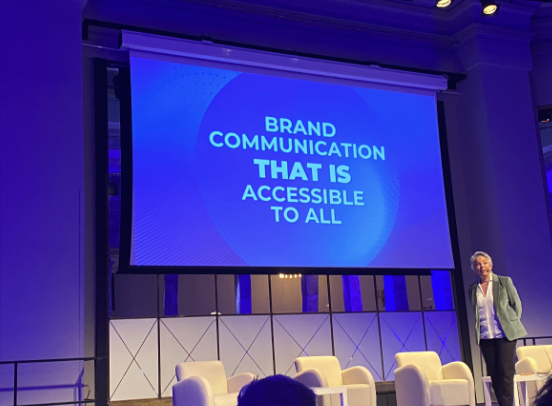
P&G Europe’s Brand Senior Vice-President, Taide Guajardo emphasised the concept of “accessible advertising” in her presentation “Resetting the Bar on Brand Communication”. Guajardo shared one of the most mind opening presentations of the conference, which touched on the changing ad formats, target audience breakdowns, ad technologies, ad creatives and many concepts from the past to the present.
Retail Media 101
Carrefour Links General Manager Alexis Marcombe addressed Retail Media from A to Z in his presentation bringing all attendees to the same point on Retail Media - one of the hottest topics of recent years. According to Marcombe; Retail Media is seen as the third wave of digital advertising after Search and Social.
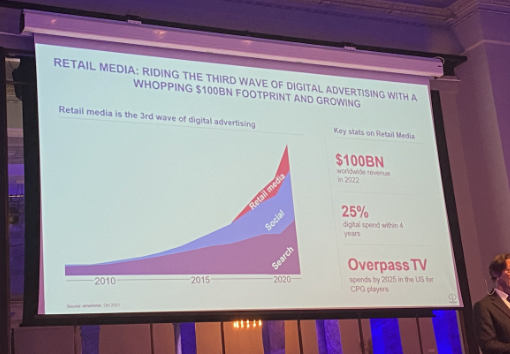 Marcombe lists the top motivations of advertisers to invest in retail media as follows:
Marcombe lists the top motivations of advertisers to invest in retail media as follows:
Streaming TV:
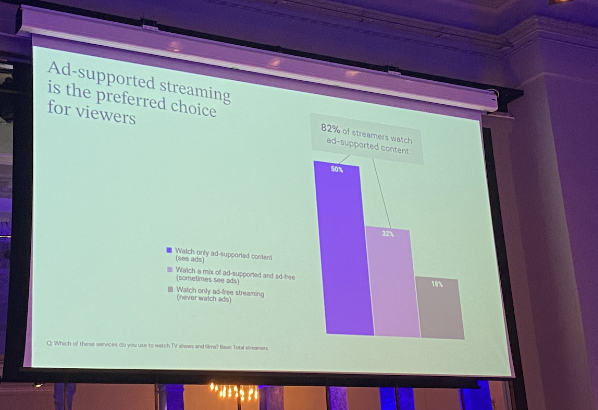 Alexandra Ong, Business Development Director at Magnite's Streaming TV's New Era: How Ads Are Powering Streaming's Future in the EU5 highlights included:
Alexandra Ong, Business Development Director at Magnite's Streaming TV's New Era: How Ads Are Powering Streaming's Future in the EU5 highlights included:
Attention Please!
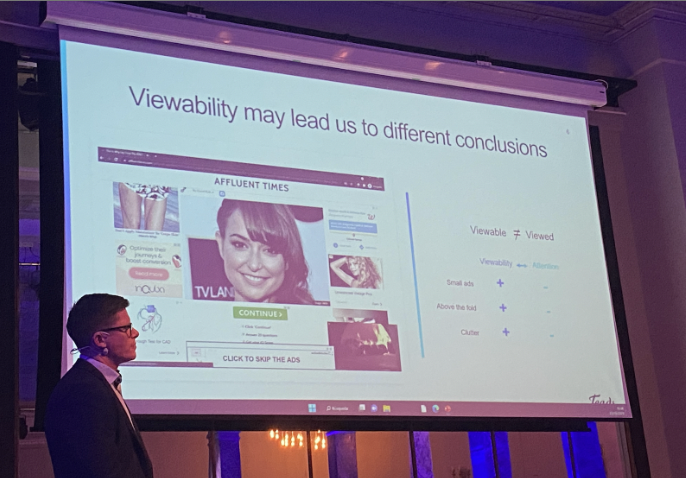
In my opinion, the most "remarkable" session of the event, both in terms of its content and the speakers’ contribution was ‘The Power of Attention’. The concept of Viewability and the Attention Economy was discussed in a joint presentation by Peter Maxwell, Global Media Lead from The Heineken Company and Phil Sumner, VP Global Research operations from Teads. Highlights from the session are as follows:
Trust & Transparency: The Future of Responsible Marketing
Trust and Transparency was addressed by Michael Todd, Global Director of Google Industry Relations. According to Todd;
The Locomotive of the European Economy: Advertising Industry
In the closing panel of the first day, the contribution of the Digital Advertising industry to the European economy was discussed. Highlights from the session are as follows:
And the Prizes…
This year’s MIXX Awards Europe winners were announced on the evening of the first day. Turkish agencies and advertiser teams won 5 awards in total. You can find the full list of awards here.

Right after the keynote speakers’ presentations, highlights and outcomes were discussed in the panels organised with the participation of people with various expertises. And there is no doubt that Circulo de Bellas Artés, the venue of Interact, was a great choice regarding the location and the fascinating ambiance. Thanks again to the IAB Europe and IAB Spain teams for the organisation!
Whether you’re a CMP, Publisher, or Vendor, discover everything you need to know about the latest version of the Transparency & Consent Framework (TCF v2.2) and what you need to do next in our latest exclusive webinar series.
Originally launched in 2018 in anticipation of the General Data Protection Regulation (GDPR) coming into force, the TCF was created by IAB Europe, in partnership with IAB Tech Lab, to help meet the needs of users, the industry, and regulators.
Now, five years on, and as part of our continued commitment to improve and develop the framework, the latest version of the TCF v2.2 has been released to respond to key changes, meet the needs of the market and help players in the digital advertising ecosystem comply with new and existing regulatory requirements.
With CMPs, Publishers, and Vendors now having until the end of Q3 2023 to make the necessary changes to respective implementations, we’ve created a dedicated webinar series to help each stakeholder understand the nuances of the latest developments and what needs to happen next to ensure a successful transition.
Check out the details below and register to secure your free place today:
Important Note: The Implementation deadline of TCF v2.have been moved from September 30th 2023 to November 2023. More information here
 This week's member guest blog post is from Maria Ramiro, Head of Business Development EU at Pteal Ads, Huawei Mobile Services Europe, who discusses her experience at OMR Festival 2023, and the prominence of AI as a topic at the event. She explores the future of AI marketing and the core elements required in order to make it thrive now.
This week's member guest blog post is from Maria Ramiro, Head of Business Development EU at Pteal Ads, Huawei Mobile Services Europe, who discusses her experience at OMR Festival 2023, and the prominence of AI as a topic at the event. She explores the future of AI marketing and the core elements required in order to make it thrive now.
It was an eventful time at this year’s OMR Festival 2023 and one thing is for sure, AI innovation was the talk of the town. When OMR polled the Festival’s participants about their favourite topics at the masterclasses, they unanimously agreed. AI-focused presentations got the highest average experience scores outshining traditional themes such as content, email or even new work. For me, it became abundantly clear that AI is no longer a buzzword. Virtually everyone now fully agrees on its boundless potential, and the natural progression forward.
The Future of AI Marketing
Over the course of this year, we have witnessed first-hand how AI is transforming the mobile marketing landscape, including new ways of reaching audiences across borders. Elvin Altun, Country Director at Mobile Marketing Association (MMA) in Germany, shared some practical examples of how AI is being used in mobile marketing already. At the OMR masterclass held by Petal Ads, she explained how marketers have adopted the use of AI generators to create distinctive visuals capable of serving multiple scenarios. She also pointed out that AI capabilities are further optimising the way we advertise by providing helpful suggestions on methods and tools we can use.
But for AI to thrive we believe that three core elements need to come together: Computing Power, Data and Algorithms. Without these three components, AI will simply not work as it should. Based on our predicted analysis, detailed in Huawei's Intelligent World 2030 report, we strongly believe that these core elements will play a pivotal role in driving the success of future AI marketing solutions. Allow me to provide you with some explanation, as well as insight into how Huawei addresses each of these core elements:
1/ Computing Power
With the advancement of technology, the computing power of devices has increased significantly, with a predicted 105 ZetaFLOPS (1021 Floating Point Operations per Second) of computing power, marking a 500x increase since 2020. This computing power is solely dedicated to processing AI applications and algorithms for connected devices. In anticipation of such processing needs, Huawei has actively focused on the development of AI infrastructure, including chipsets, processors, and servers, to ensure the provision of abundant computing power necessary to drive AI algorithms. This ability to analyse vast amounts of data in real-time will empower advertisers to optimize their campaigns and enhance engagement.
2/ Data
The volume of connected devices has witnessed a substantial increase in recent years, accompanied by advancements in connectivity, notably the emergence of 5G capabilities. Our projections indicate that the number of smart devices is expected to reach 200 billion by 2030. This surge in connected devices is set to generate a significant accumulation of data, resulting in the expansion of storage capacity by 23x since 2020, equivalent to 1 Yottabyte or one million trillion megabytes. Recognizing the potential value of such vast data, Huawei adopts a comprehensive approach, utilizing both hardware and software aspects to effectively collect and harness it.
3/ Algorithms
Given the vast amounts of data available, it is fundamental to leverage machine learning and deep learning techniques to gain insights and effectively target your audience. Huawei capitalizes on this by incorporating advanced algorithms within our Petal Ads platform. This empowers us to elevate on-device advertising to unparalleled heights of effectiveness and efficiency, allowing for precise audience targeting and enhanced advertising outcomes.
Harnessing On-Device AI Advertising to Reach Chinese Shoppers
AI capabilities and recent breakthroughs in how AI is being applied have inspired us at Petal Ads to explore mobile ad solutions targeting China’s growing outbound travel and tourism market.
Over the past six months, we have witnessed more than 2.5 million Huawei device users from China venturing into the EU, and this figure is expected to rise to reach two-thirds of the 2019 level when 13 million Chinese tourists came to the EU¹. What's more, is that over 70% of these travellers heavily rely on smartphones to get around.
As these Chinese travellers eagerly anticipate the opportunity to purchase tax-refundable goods, there is a strong expectation of a surge in demand for such products. To cater to the needs and preferences of these typically high-value consumers, we’re currently working with several multinationals in the luxury retail, automotive and travel industry. Specifically, these brands are trialling Petal Ads' capabilities to target and segment Chinese users travelling to Europe or particular countries. To enhance targeting effectiveness, Petal Ads customises campaigns to be either specifically tailored for overseas platforms or precisely catered to Chinese platforms, or both depending on campaign goals.
To make any significant impact targeting Chinese consumers it is crucial to use the right advertising strategy. Whilst that’s always been a challenge in itself, I’m encouraged by the fact that AI’s integration into mobile marketing is real and happening as we speak. Moreover, it has coincided with the advertising sector in China projected to reach 6.3% growth in 2023² and a promising outlook forecasting 30% increase in international travel among Chinese consumers³.
Sources:
¹Eurostat ING Research, Oxford Economics 2023
²GroupM advertising forecast for China; March 8, 2023
³Tourism Economics, March 2023
Are you a motivated individual looking to embark on a career in EU affairs? Are you seeking a hybrid and flexible traineeship opportunity? Join our multicultural and dynamic team based in Brussels, where you will have the chance to take on responsibilities from day one and foster your professional growth.
About IAB Europe:
IAB Europe is the leading European-level association for the digital marketing and advertising ecosystem. Our membership includes media, marketing, and high-end technology companies. As a Public Policy Trainee, you will play a vital role in shaping the digital advertising and marketing policy landscape in Europe.
Responsibilities/Scope of Work:
As a Public Policy Trainee, you will closely collaborate with IAB Europe's Public Policy Manager and the Director of Public Policy. Your primary responsibilities will include:
About you:
To be considered for the role of Public Policy Trainee at IAB Europe, you should meet the following criteria:
What we offer:
If you are a motivated and passionate individual with an appetite for EU affairs and a desire to make an impact in the digital advertising and marketing industry, we encourage you to apply for this exciting opportunity.
To apply, please submit your resume and a cover letter explaining your interest in the position to policyteam@iabeurope.eu. The application deadline is June 16, 2023.
We appreciate all applications, but please note that only shortlisted candidates will be contacted for an interview.
IAB Europe is an equal opportunity employer and welcomes applicants from diverse backgrounds.

According to IAB Europe’s Annual Flagship Event Interact, 2023 is the year of action for our industry. But when the world feels so uncertain and the pressure to unlock efficiencies and generate growth is greater than ever, how do you know what action to take?
The key lies in understanding what’s driving people today to anticipate what will matter to them tomorrow – and this is where Meta’s annual trends report, Culture Rising 2023, comes in.
With more than 3 billion people using at least one of our apps daily, Culture Rising uses today’s insights to predict tomorrow’s opportunities. Drawing on rising conversation topics and hashtags across Facebook and Instagram, we bring you 20 trends to watch, grouped into four themes in this global survey. In this blog, I unpack these four themes to give you an idea of what’s shifting, what’s sticking, and what we can expect next.
1) Exploratory identities
How we see ourselves defines how we view the world and our place in it. Yet our identities aren’t fixed but constantly evolving, just like we are. This is something we heard from IAB Europe’s Chief Economist, Daniel Knapp, during our IAB Europe Industry Insiders webinar on Culture Rising. With people exploring and building identity throughout their lives, what brands think they know about their audiences is always shifting. This is an opportunity for brands as their customers tend to be receptive to new ways of thinking, new habits, and new products over their lifetime.
2) Refined relationships
Our relationships have long been one of the core drivers of our happiness, but how we connect with each other or the things we love is changing. We look for a date on one platform but keep in touch with our friends on another. We join online groups to further our passion but look to creators for inspiration. Similarly, brands should be rethinking their key relationships and the channels through which they can be nurtured. Whether your brand is looking to deepen existing relationships, broaden its reach, or deliver a more authentic experience for customers, seeking out diverse creators or harnessing new technologies like AR can help you meet your customers where they are.
3) Assertive aspirations
In good but especially in bad times, hope is what keeps us going. The ambition to do more, to be better, to find meaning, and to leave our mark is not only part of who we are, but what keeps us going. Tough economic times coming on the heels of a global pandemic means we could all use a little boost from unexpected places and that includes from brands we love. Whether you draw on your brand’s expertise, the causes you champion, or your unique personality, now is a time for brands to speak to people’s aspirations and feed their ambition.
4) Lived values
People are increasingly looking to translate hashtags into action and live up to their values. Whether it’s wellness, sustainability or mental health, we’re looking for ways to walk the talk. We want our choices to be in line with who we are and what we care about. We hold ourselves, our friends, and increasingly, the businesses we choose to support to a higher standard. We expect brands not only to have the same taste as us but also to anticipate our preferences and share our aspirations - not unlike we would a friend. And whilst it’s unlikely that anyone will call customer service just to hang out, customers do expect brands to be responsive to their needs, respectful of their time, and mindful of their shifting preferences. As tech evolves and expectations rise, might you want to consider “BFF brand” status a new, potential north star?
Beyond the four trends we’ve outlined above, our Culture Rising report shows that our wants, needs, and preferences are complex and ever-changing, just like we are. But whilst we once lacked the tools to appreciate what motivates us today and why, we can now use data, analytics, and emerging tech like artificial intelligence (AI) to anticipate with increasing accuracy what will drive us tomorrow. And for brands, that could change the game.
If these themes have sparked your interest and you want to learn more, you can download the full Culture Rising 2023 report with all 20 trends.
On 23rd and 24th May 2023, IAB Europe hosted its flagship annual event ‘Interact’ in Madrid, Spain!
Thanks to the support of our sponsors and media partners, and the wonderful team at IAB Spain, we enjoyed two days of keynote speeches, panel discussions and networking under the central theme of ‘Innovation, Sustainability & Growth’.
We unpacked a whole host of topics from the attention economy, CTV, and retail media, through to premium publisher’s advertising models, sustainability, and more.
Thanks so much to everyone who joined us and thank you to all of the amazing speakers who came together from across Europe and beyond to share their incredible insights and expertise.
Coming soon - Catch Up on Demand
With over 275 people joining over the two days, we are delighted to call it a great success.
If you didn’t have the opportunity to join us, fear not! We will soon be sharing a full wrap up of Interact soon with videos and images of some of the key sessions so you can view in your own time.
In the meantime, why not check out some of the Interact highlights below..
Interact 2024 – Stay Tuned!
We hope you will be able to join us next year! Stay tuned for the reveal of the next location and get ready to pop the date in your diary as we prepare for Interact 2024.
In the meantime, if you’d like to know more about IAB Europe or how you can get involved in Interact 2024 please do reach out to communication@iabeurope.eu







We’re teaming up with DoubleVerify to invite you to participate in an exclusive survey that aims to understand more about Connected TV Advertising in Europe. What are your key priorities in CTV? What is Driving your investment? Or are there any challenges without an active solution?
Have your say in our survey before 2nd June and be in with a chance of winning a €200 Amazon Voucher!
CTV advertising is continuing to gain traction across the region and the aim of this survey is to gather both buy and sell-side perspectives on the challenges, drivers, measurement approaches and future of CTV advertising.
The survey will take less than ten minutes to complete and all responses will be treated with the strictest confidence. All respondents will receive the research results directly to their email if provided.
The results will be used to provide insights into how CTV is developing in Europe and what areas still need to be addressed. Take part in the survey here today.
We will be selecting a participant, at random, to win a €200 Amazon voucher. So what are you waiting for? Share your expertise and enter for your chance to win.
On the 4th of May, IAB Europe hosted its first Virtual Programmatic Day to discuss and debate the latest trends, drivers, and barriers impacting programmatic trading in Europe.
This event brought industry experts together to discuss the value and evolution of programmatic, programmatic omnichannel, the programmatic angle of Retail Media and commerce, and what the future holds for programmatic, including AI.
A big thank you to our event partner Xaxis for hosting this hybrid event.
In this post, you will find an overview of each of the sessions as well as links to the video recordings for you to view in your own time. Enjoy!
Panel Discussion with Audience Q&A: The Value and Evolution of Programmatic – From Header Bidding to SPO to Conquering AV & TV

Programmatic advertising has transformed the way digital ads are brought and sold. First introduced to the market in the mid-2000s through the advent of real-time bidding (RTB) technology, advertisers can now target specific audiences with greater precision and efficiency through automation. Something that adds immense value to any media plan. But what is the real value of programmatic today and how has it evolved from Header Bidding and Supply Path Optimisation (SPO) to tackling new and emerging channels and formats such as AV and TV?
Jaidev Kakar, Director, Advertiser Solutions, EMEA at PubMatic, moderated this session and was joined by:
Watch the session recording here
Panel Discussion with Audience Q&A: Programmatic Omnichannel

In this session, a panel of experts discussed the challenges and opportunities of programmatic omnichannel campaigns. They addressed how the programmatic ecosystem has evolved to enable the delivery of effective omnichannel campaigns and what we can expect to come in this area.
Rebecca Rose, Head of Clients EMEA, Verve Group moderated this session and was joined by:
Watch the session recording here
Panel Discussion with Audience Q&A – Retail & Commerce Media – The Programmatic Angle
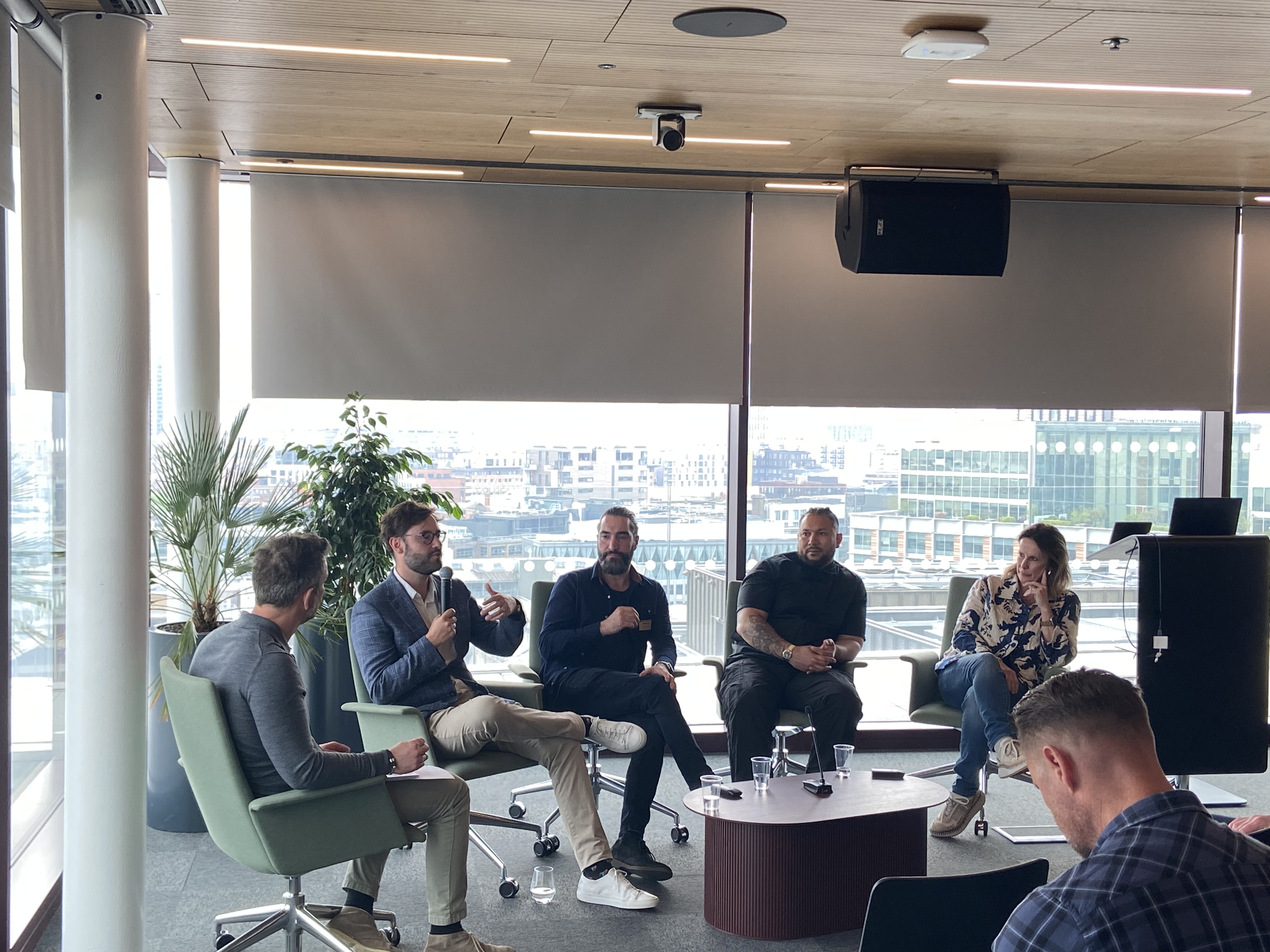
Retail media is no longer an ‘emerging’ channel and is expected to reach 25bn in ad spend by 2026. But what impact do programmatic capabilities have on retail and commerce ads? This panel of experts discussed this plus how retail and commerce media can be planned, bought, and sold programmatically.
This session was moderated by Nick Welch, Head of Programmatic, EMEA, Integral Ad Science (IAS) & Chair of IAB Europe’s Programmatic Trading Committee who was joined by:
Watch the session recording here
Panel Discussion with Audience Q&A – AI & The Future of Programmatic

AI is widely adopted and utilised in the programmatic space, with DSPs creating machine learning algorithms and buyers adopting key processes to help optimise toward campaign success but what does the future look like and how will AI technologies help advance programmatic trading and the digital advertising industry?
In this session, a panel of industry experts discussed the role that AI and new technologies play in programmatic advertising, the current opportunity and challenges in this space, and what the future holds with new technologies and innovations on the horizon.
Chloe Nicholls, Head of Ad Tech at IAB UK moderated this session and was joined by:
Watch the session recording here
If you’d like to find out more about programmatic and view some of the work of our Programmatic Trading Committee, please check out the links below:
Just like last year, the OMR Festival is expected to draw more than 70,000 visitors to the Hamburg Messe on the 9th & 10th of May, 2023. On over 100,000 sqm of space, #OMR23 offers the digital and marketing industry a robust program of Conference keynotes, Masterclasses, Guided Tours, Side Events and Expo on both days. More than 800 experts will take to the six OMR stages for keynotes, panel discussions and interviews. The speaker lineup at this year's OMR Festival once again offers A-listers from Europe and beyond.
Serena Williams is coming to OMR Festival 2023
Headlining #OMR23 is Serena Williams, who has made a name for herself far beyond the tennis court. A native of Los Angeles, Williams has more singles titles than any other player in history on-the-court, off of the court she has built up a personal brand with worldwide pull. With her fashion brand "S by Serena" and jewellery brand "Serena Williams Jewellery," she provides a platform to issues of body positivity and female empowerment. Since March 2022, she has been active as an investor by founding Serena Ventures. A USD 111m fund, Serena Ventures already has 60 companies in its portfolio and focuses on supporting entities with diverse founding teams. Among them are fintechs like Propel and Cointracker, the billion-dollar company Masterclass and smoothie delivery service Daily Harvest. In addition, Serena Ventures has a stake in Esusu, one of the first tech unicorns with Black founders at the helm. Visitors to #OMR23 will be able to hear Williams discuss her career post-tennis on the OMR Conference Stage.
Climate activist Luisa Neubauer at #OMR23
She is probably the most-prominent face in the German climate movement. She’s the co-organizer of Fridays for Future and one of Time Magazine’s TIME100 Next—a list of the top 100 up-and-coming individuals. We are talking about Luisa Neubauer.
In 2018, Luisa Neubauer met the Swedish student Greta Thunberg at the UN Climate Change Conference, was inspired and, together with other activists, launched the “Fridays for Future” movement in Germany, following the example of the Swedish original. Listing the full scope of the movement’s impact would require a standalone article to do the movement justice. The very brief synopsis: Neubauer has helped organise hundreds of climate strikes, regularly confronts politicians, meets global heads of state and government officials and has attended four UN climate conferences as an activist. Her goal - and that of the global climate movement - to meet the UN’s 1.5-degree target agreed to at the 2015 Paris Climate Conference. To inch closer to meeting this goal, Luisa Neubauer and Fridays for Futures have cleverly weaponized the rules of the attention economy. For starters, Neubauer is the host of the Spotify climate podcast “1.5 degrees,” she’s published three books detailing the ecological crises from different angles and in 2021 she and others won a formal constitutional complaint against the German government, which was historic to say the least.
Media mogul, innovator, CEO and entrepreneur: Scooter Braun
We are so excited we got him: Born and raised in NYC, Scooter Braun is one of the most-successful and recognizable music managers and businessmen in the world. As a manager, his artist portfolio features a who’s who of the world’s biggest superstars. But it would be reductive to label him as merely a music manager. A serial entrepreneur, investor, film producer, dedicated philanthropist, innovator and investor in companies like UBER and Spotify, Braun’s broad scope of expertise makes him one of the most intriguing speakers ever to come to OMR. On the #OMR23 Conference Stage, Braun will discuss his work, success, failures and vision, while also sharing insights into his prolific career and talking about the importance of giving back as much as possible.
The man, the Kith, the lifestyle legend: Ronnie Fieg
Ronnie Fieg’s lifestyle brand Kith is flying higher than ever. Kith just dropped lookbooks with Jerry Seinfeld, Edward Norton and Bryan Cranston and in addition Fieg took on a little part-time gig in November 2022 as the first-ever creative director for the New York Knicks. Simply put, he knows what’s up in fashion and has an acute understanding of which levers and hype mechanics to activate for his clothing. One strategy: Kith stores are an experience unto themselves and have become a sort of place of pilgrimage for many fans - granola and ice cream on the house.
Find out more and get tickets here
 A note from IAB Europe's CEO, Townsend Feehan on her remarks for delivery at the DG Just Stakeholder Roundtable on the Initiative for a voluntary business pledge to simplify the management by consumers of cookies and personalised advertising choices.
A note from IAB Europe's CEO, Townsend Feehan on her remarks for delivery at the DG Just Stakeholder Roundtable on the Initiative for a voluntary business pledge to simplify the management by consumers of cookies and personalised advertising choices.
Thank you for the invitation to attend today (Friday 28th April) and the opportunity to participate in DG JUST’s reflection over the coming months.
In my speaking time, I would like to call out two assumptions in the Discussion Note circulated in advance of today’s meeting that are worth bearing in mind, and two ways that IAB Europe can support the reflection.
First, the Discussion Note helpfully acknowledges that personalised advertising delivers benefits to both consumers and advertisers. The reality is that personalisation is attractive to advertisers because it offers the prospect of less wasted spend; the Discussion Note explicitly suggests that consumers understand and accept this fact.
Second, the Discussion Note’s focus on improving information to consumers seems to confirm DG JUST’s continuing faith in the information-and-choice paradigm for European consumers on which existing privacy and data protection law are based (as opposed to contemplating a different paradigm that would take choice and control out of consumers’ hands).
These seem to us to be important and positive foundational assumptions.
With respect to how IAB Europe can support the reflection that is being kicked off today, we believe we are well-placed to contribute to each of the two key areas of focus laid out in the Discussion Note.
First, with respect to information to be provided to consumers, IAB Europe can help give practical effect to a future DG JUST pledge by ensuring that its Transparency & Consent Framework (TCF), which is implemented on hundreds of thousands of EU websites, integrates additional information disclosures. TCF is a best-practice minimum standard that helps websites solicit, establish, record, and signal a GDPR legal basis and ePrivacy consent for data processing for advertising. The TCF dialogue box that opens when a user visits a website or app for the first time could be modified to include an explicit reference in the first layer to the site being “ad-funded”, or “partially dependent on advertising revenue”, or “ad-free and subscription-based”. The dialogue box could also explicitly state that content is offered in exchange for a willingness to receive advertising. TCF UIs already indicate what “trackers” or other personal data the website or app is asking for user agreement to process, for what purpose(s), and the legal basis/es for processing (whether consent or legitimate interests) if the user agrees.
Second, with respect to exploring “alternatives to tracking-based advertising” that are also personalised in some way, we can provide insight into the state of play on the industry’s own work to identify and further develop alternatives to third-party cookies and help the stakeholders participating today understand the implications of that work for consumers. As DG JUST and other colleagues here today will be aware, there are already alternatives (for example, personalisation based solely on context) and work to identify means of personalising advertising that do not involve the use of cookies has been accelerated in recent years by technology and business decisions taken by browser and operating system manufacturers.
It is important that this reflection be clear-eyed about there being winners and losers in any evolution of the paradigm. As an example, arguably contextual advertising works for eCommerce platforms, single-topic or ‘niche’ sites, and large news sites that have the resources to run sports and lifestyle feature sections, but less well – or not at all – for smaller news sites that do not have those resources. Even large news organisations using only contextual would need to let a great deal of content go “unmonetised” as it is difficult to match advertising content to serious news content. Similarly, certain news media platforms cannot build commercially attractive audience segments based solely on first-party data due to their content being limited to “serious” news, user engagement with which reveals nothing about a product or service that someone might be interested in buying.
And when specific categories of online actors “lose”, the consumers that have benefited from free or low-cost access to their content and services also lose.
IAB Europe would be pleased to host a workshop to which DG JUST and all attendees of today’s Roundtable would be invited to present the state of play on the development of these alternative models. I hereby formally extend that invitation.
We are looking forward to participating in this important reflection between now and the end of the year.
Thank you again,
Townsend Feehan, CEO, IAB Europe
On the 18th of April, IAB Europe hosted its first hybrid Great Debate event of 2023 to discuss and debate Retail Media.
This event brought industry experts together to discuss how the Retail Media market in Europe is developing, how a Retail Media solution can be developed, key measurement principles to consider, and how Retail Media investment can provide effective closed-loop measurement.
In this post, you will find an overview of each of the sessions as well as links to the video recordings for you to view in your own time. Enjoy!
Keynote Presentation: The Retail Media Landscape in Europe with IAB Europe’s Chief Economist Daniel Knapp
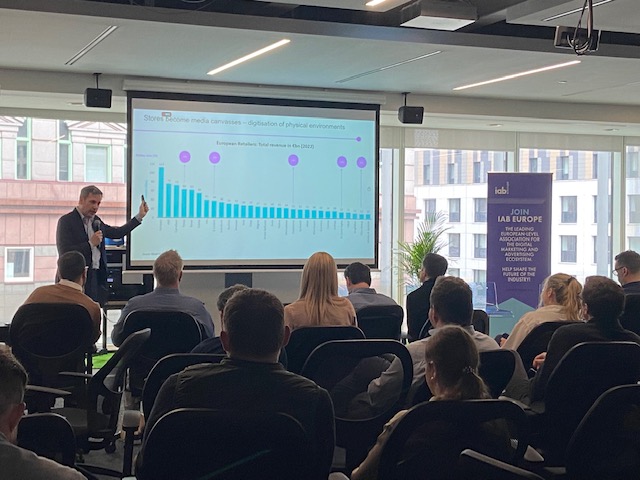
In this keynote presentation, Daniel shared the latest stats and facts on the Retail Media landscape and the opportunities available in Europe today. He shared why he feels too many marketers are still seeing retail media as nothing more than a dedicated channel and instead that it is “an infrastructure that will bring about great change in digital advertising”.
If you’re a member of IAB Europe and would like to receive the presentation deck, please email Marie-Clare (puffett@iabeurope.eu)
Watch the session recording here
Panel Discussion with Audience Q&A: The Retail Media Landscape in Europe
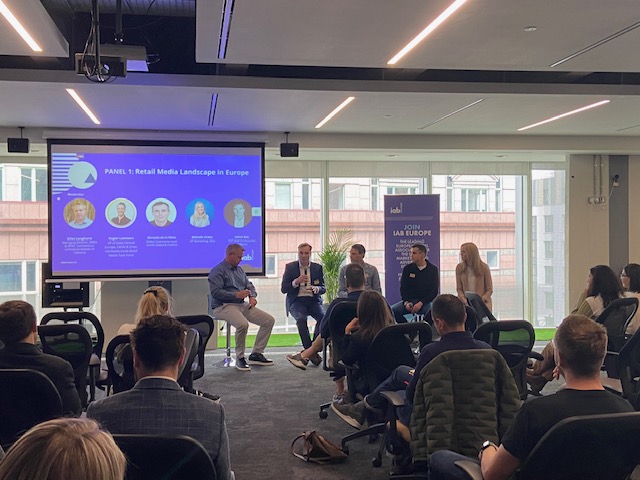
A panel of industry experts discussed the key trends and developments happening in the Retail Media market across Europe. They shared how Retail Media is brand safe and a win win win for advertisers, and how it is a good way to reach engaged audiences. They also addressed key challenges around transparency and technical implementations that still need to be overcome.
Giles Longhurst, Managing Director, EMEA & APAC, Connexity (e-commerce division of Taboola) moderated this session and was joined by:
Watch the session recording here
Panel Discussion with Audience Q&A: Retailer 101 – What You Need to Know
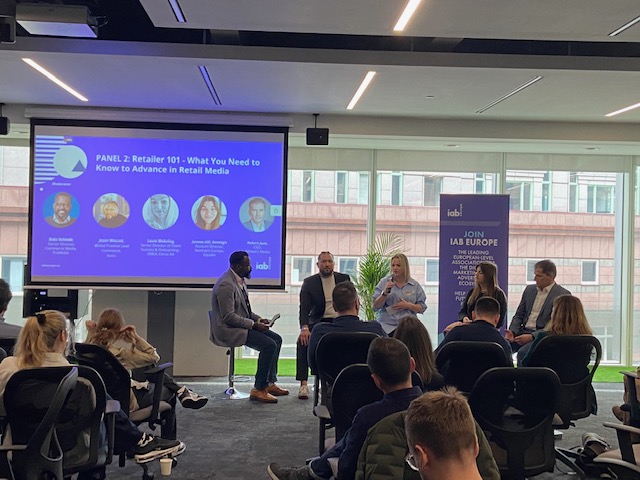
In this session, a panel of retail media experts came together to share insights and best practices from their own businesses. They discussed the need to be bold to monetise the retail media space, as there is such high demand for it, and the importance of opening up the opportunity to purchase and creating standardisaton to establish a successful retail media solution.
Babs Kehinde, Senior Director, Commerce Media at PubMatic moderated this session and was joined by:
Watch the session recording here
Panel Discussion with Audience Q&A – Closing the Loop – Retail Media Measurement
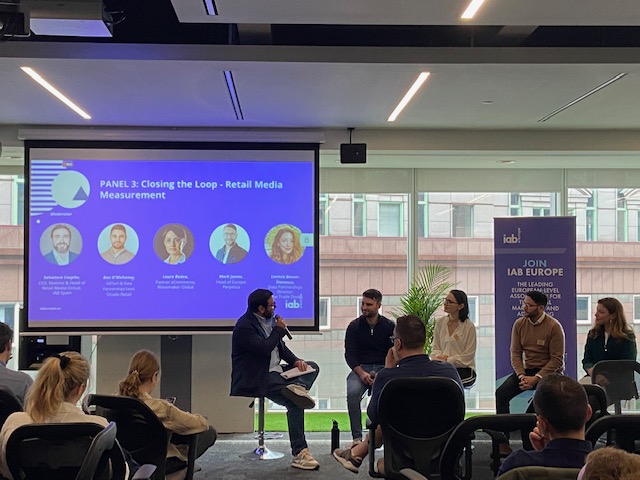
Our final panel of industry experts rounded up the above-mentioned conversations to discuss how Retail Media offers the promise of closed-loop measurement. They discussed the importance of first-party data for measurement, the advantages for advertisers being able to optimise in real-time - “By directly matching customer ID data with impressions, it is transforming how we are optimising our advertising budgets.” Laura Badea, Partner eCommerce at Wavemaker - and the value of data clean rooms in this process.
Salvatore Cospito, CEO, Reetmo & Head of Retail Media Group, IAB Spain moderated this session and was joined by:
Watch the session recording here
If you’d like to find out more about our Retail Media event and access other available materials on the topic, please follow the links below:
"*" indicates required fields